Contents
- 1. User manual 1 of 5
- 2. User manual 2 of 5
- 3. User manual 3 of 5
- 4. User manual 4 of 5
- 5. User manual 5 of 5
User manual 5 of 5

Chapter 20 Game Center 98
Play games with friends
Invite friends to a multiplayer game. Tap Friends, choose a friend, choose a game, then tap
in the upper right. If the game allows or requires more players, choose the players, then tap Next.
Send your invitation, then wait for the others to accept. When everyone’s ready, start the game.
Ifafriendisn’tavailableordoesn’trespond,youcantapAuto-MatchtohaveGameCenternd
another player for you, or tap Invite Friend to invite someone else.
Send a friend request. Tap Friends, tap , then enter your friend’s email address or Game Center
nickname. To browse your contacts, tap . (To add several friends in one request, type Return
after each address.) Or tap any player you see anywhere in Game Center.
Challenge someone to outdo you. Tap one of your scores or achievements, then tap
Challenge Friends.
What are your friends playing and how are they doing? Tap Friends, tap your friend’s name,
then tap the Games or Points bubble.
Want to purchase a game your friend has? Tap Friends, then tap his or her name. Tap the Games
bubble, tap the game in the list, then tap in the upper right.
Make new friends. To see a list of your friend’s friends, tap Friends, tap your friend’s name, then
tap his or her Friends bubble.
Unfriend a friend. Tap Friends, tap the friend’s name, then tap in the upper right.
Keep your email address private. TurnoPublicProleinyourGameCenteraccountsettings.
See Game Center settings, below.
Turn o multiplayer activity or friend requests. Go to Settings > General > Restrictions. If the
switchesaredimmed,rsttapEnableRestrictionsatthetop.
Keep it friendly. Toreportoensiveorinappropriatebehavior,tapFriends,taptheperson’sname,
tap in the upper right, then tap Report a Problem.
Game Center settings
Go to Settings > Game Center, where you can:
•Sign out (tap your Apple ID)
•Allow invites
•Letnearbyplayersndyou
•EdityourGameCenterprole(tapyournickname)
•Get friend recommendations from Contacts or Facebook
Specify which notications you want for Game Center. GotoSettings>Notications>Game
Center.IfGameCenterdoesn’tappear,turnonNotications.
Change restrictions for Game Center. Go to Settings > General > Restrictions.
Apple Confidential

21
99
Newsstand organizes your magazine and newspaper apps, and automatically updates them
when iPod touch is connected to Wi-Fi.
Touch and hold
a publication to
rearrange.
Touch and hold
a publication to
rearrange.
Find Newsstand
apps.
Find Newsstand
apps.
Note: You need an Internet connection and an Apple ID to download Newsstand apps, but you
can read downloaded content without an Internet connection. Newsstand is not available in
all areas.
Find Newsstand apps. Tap Newsstand to reveal the shelf, then tap Store. When you purchase a
Newsstand app, it’s added to the shelf. After the app is downloaded, open it to view its issues
and subscription options. Subscriptions are In-App purchases, billed to your Apple ID account.
Turn o automatic updates. AppsupdateautomaticallyoverWi-Fi,unlessyouturnotheoption
in Settings > General > Background App Refresh.
Newsstand
Apple Confidential

22
100
iTunes Store at a glance
Use the iTunes Store to add music, movies, TV shows, and more to iPod touch.
See purchases,
tones, audiobooks,
and more.
See purchases,
tones, audiobooks,
and more.
View your
lists.
View your
lists.
Browse
Browse
Note: You need an Internet connection and an Apple ID to use the iTunes Store. The iTunes Store
is not available in all areas.
Browse or search
Browse by category or genre. Tap one of the categories (Music, Movies, or TV Shows). Tap Genres
torenethelist.
If you know what you’re looking for, tap Search. You can tap a search term that’s trending
amongotheriTunesusers,orenterinfointhesearcheld,thentapSearchagain.
Access family members’ purchases. With Family Sharing turned on, you can view and download
songs, TV shows, and movies purchased by other family members. Tap Purchased, tap your name
or My Purchases, then select a family member from the menu.
Find it with Siri. Siri can search for items and make purchases in the iTunes Store. For example,
you can say “Get a new ringtone” or “Purchase song name by band name.” You can ask Siri to
download a podcast or redeem a gift card. For best results, say “purchase” instead of “buy” at the
beginning of a Siri command.
iTunes Store
Apple Confidential

Chapter 22 iTunes Store 101
Ask Siri to tag it. When you hear music playing around you, ask Siri “What song is playing?” Siri
tells you what the song is and gives you an easy way to purchase it. It also saves it to the Siri tab
in the iTunes Store so you can buy it later. Tap Music, tap , then tap the Siri tab to see a list of
tagged songs available for preview or purchase.
Tap to see your
Wish List and
recommendations.
Tap to see your
Wish List and
recommendations.
Discover great new music on iTunes Radio. When you listen to iTunes Radio, songs you play
appear in the Radio tab in the iTunes Store so you can preview or purchase them. Tap Music, tap
, then tap Radio.
Preview a song or video. Tap it.
Add to your Wish List. When you hear something you hope to buy from the iTunes Store, tap
, then tap Add to Wish List. To view your Wish List in the iTunes Store, tap Music, Movies, or TV
Shows, tap , then tap Wish List.
Tired of tapping More? To rearrange the buttons, tap More, then tap Edit. To replace a button,
drag another icon over the one you want to replace. Then tap Done.
Purchase, rent, or redeem
Tap an item’s price (or tap Free), then tap again to buy it. If you see instead of a price, you’ve
already purchased the item and you can download it again without a charge.
Approve purchases with Family Sharing. With Family Sharing set up, the family organizer can
review and approve purchases made by family members under the age of 18. For example, if
Parent/Guardian>AsktoBuyissetforspecicminorfamilymembers,whenthosememberstry
to make a purchase, a message is sent to the family organizer for approval. For more information
about setting up Family Sharing, see Family Sharing on page 32.
Apple Confidential

Chapter 22 iTunes Store 102
Note: Age restrictions for Ask to Buy vary by area. In the United States, the family organizer can
enable Ask to Buy for any family member under age 18; for children under age 13, it’s enabled
by default.
Hide individual purchases. Using iTunes on a computer, family members can hide any of their
purchases so other family members can’t view or download them. For more information, see
Family Sharing on page 32.
Use a gift card or code. Tap a category (for example, Music), scroll to the bottom, then tap
Redeem. Or tell Siri “Redeem an iTunes Store gift card.”
Use iTunes Pass. You can add an iTunes Pass to Passbook, which makes it easy to add money to
your Apple ID so you can make purchases from the iTunes Store, App Store, and iBooks Store
without using a credit or debit card. To add your iTunes Pass in iTunes Store, tap a category, scroll
to the bottom, tap Redeem, then tap Get Started under iTunes Pass. You can add money to your
iTunes Pass at Apple Retail Stores in most countries.
Send a gift. View the item you want to give, tap , then tap Gift. Or tap one of the categories
(Music, Movies, or TV Shows), scroll to the bottom, then tap Send Gift to send an iTunes gift
certicatetosomeone.
See the progress of a download. Tap More, then tap Downloads.
Bought something on another device? Go to Settings > iTunes & App Store to set up automatic
downloads on your iPod touch. You can always view your purchased music, movies, and TV
shows in the iTunes Store (tap More, then tap Purchased).
Watch your time with rentals. In some areas, you can rent movies. You have 30 days to begin
watching a rented movie. After you start watching it, you can play it as many times as you want
in the allotted time (24 hours in the U.S. iTunes Store; 48 hours in other countries). Once your
time’s up, the movie is deleted. Rentals can’t be transferred to another device; however, you can
use AirPlay and Apple TV to view a rental on your television.
iTunes Store settings
To set options for the iTunes Store, go to Settings > iTunes & App Store.
View or edit your account. Tap your Apple ID, then tap View Apple ID. To change your password,
taptheAppleIDeld,thentapPassword.
Sign in using a dierent Apple ID. Tap your account name, then tap Sign Out. You can then enter
adierentAppleID.
Subscribe to or turn on iTunes Match. You can subscribe to iTunes Match, a service that stores
your music and more in iCloud. See iCloud and iTunes Match on page 61. If you’re a subscriber,
tap iTunes Match so you can access your music on iPod touch anywhere. Tap “Learn more” for
more information about iTunes Match.
Turn on automatic downloads. Tap Music, Books, or Updates. Content updates automatically
overWi-Fi,unlessyouturnotheoptioninAutomaticDownloads.
Apple Confidential

23
103
App Store at a glance
Use the App Store to browse, purchase, and download apps to iPod touch. Your apps update
automaticallyoverWi-Fi(unlessyouturnothisfeature),soyoucankeepupwiththelatest
improvements and features.
View purchases
and updates.
View purchases
and updates.
Browse
Browse
Explore apps by
category and popularity.
Explore apps by
category and popularity.
See your Wish
List and other
suggestions
for you.
See your Wish
List and other
suggestions
for you.
Note: You need an Internet connection and an Apple ID to use the App Store. The App Store is
not available in all areas.
Find apps
If you know what you’re looking for, tap Search. Or tap Categories to browse by type of app.
Ask Siri to nd it. Siri can search for items and make purchases in the App Store. For example, tell
Siri to “Find apps by Apple” or “Purchase app name.”
Access family members’ apps. With Family Sharing turned on, you can view and download apps
purchased by other family members. Tap Purchased, tap your name or My Purchases, then select
a family member from the menu. For more information, see Family Sharing on page 32.
Want to tell a friend about an app? Find the app, tap , then choose the method. See Share
from apps on page 32.
App Store
Apple Confidential
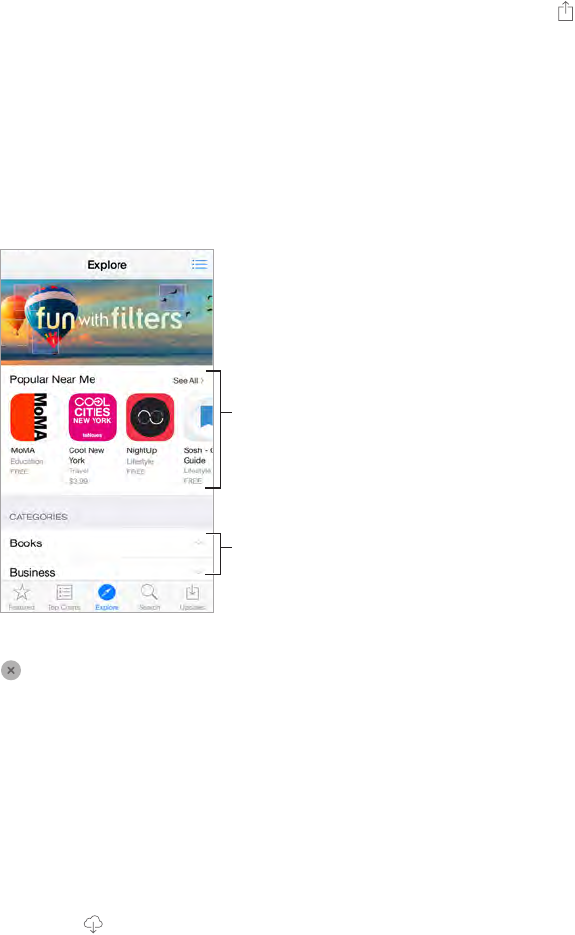
Chapter 23 App Store 104
Use Wish List. To track an app you might want to purchase later, tap on the app page, then
tap Add to Wish List.
Search apps by category. Tap Explore, scroll to Categories, then tap a category to focus on the
appsyouwant,forexample,Education,Medical,orSports.Tapsubcategoriestofurtherrene
your results.
What apps are being used nearby? TapExploretondoutthemostpopularappsothersaround
you are using (Location Services must be on in Settings > Privacy > Location Services). Try this at
a museum, sporting event, or when you’re traveling, to dig deeper into your experience.
Tap to learn
more, download,
or purchase.
Tap to learn
more, download,
or purchase.
Check out apps
in your areas of
interest.
Check out apps
in your areas of
interest.
Delete an app. Touch and hold the app icon on the Home screen until the icon jiggles, then tap
.Whenyounish,presstheHomebutton.Youcan’tdeletebuilt-inapps.Deletinganappalso
deletes its data. You can download any app you’ve purchased from the App Store again, free
of charge.
For information about erasing all of your apps, data, and settings, see Reset iPod touch
settings on page 154.
Purchase, redeem, and download
Tap the app’s price, then tap Buy to purchase it. If it’s free, tap Free, then tap Install.
If you see instead of a price, you’ve already purchased the app and you can download it
again, free of charge. While the app is downloading or updating, its icon appears on the Home
screen with a progress indicator.
Approve purchases with Family Sharing. With Family Sharing set up, the family organizer can
review and approve purchases made by family members under the age of 18. For example, if
Parent/Guardian>AsktoBuyissetforspecicminorfamilymembers,whenthosememberstry
to make a purchase, a message is sent to the family organizer for approval. For more information
about setting up Family Sharing, see Family Sharing on page 32.
Apple Confidential
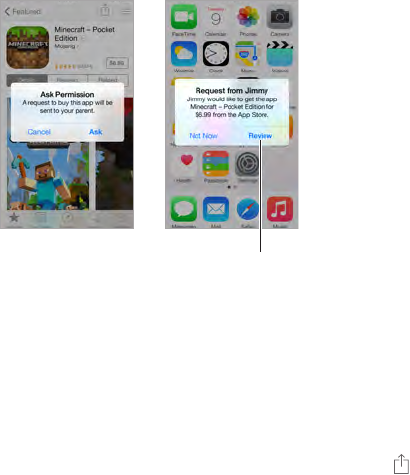
Chapter 23 App Store 105
Note: Age restrictions for Ask to Buy vary by area. In the United States, the family organizer can
enable Ask to Buy for any family member under age 18; for children under age 13, it’s enabled
by default.
Find out more about
the requested app.
Find out more about
the requested app.
Hide individual purchases. Using iTunes on a computer, family members can hide any of their
purchases so other family members can’t view or download them. For more information, see
Family Sharing on page 32.
Use a gift card or code. Tap Featured, scroll to the bottom, then tap Redeem. Or tell Siri “Redeem
an iTunes Store gift card.”
Send a gift. View the item you want to give, tap , then tap Gift. Or tap Featured, scroll to the
bottom,thentapSendGifttosendaniTunesgiftcerticatetosomeone.
Restrict in-app purchases. Many apps provide extra content or enhancements for a fee. To limit
purchases that can be made from within an app, go to Settings > General > Restrictions (make
sure Restrictions is enabled), then set options (for example, restrict by age rating or require a
passwordimmediatelyorevery15minutes).YoucanturnoIn-AppPurchasestopreventall
purchases. See Restrictions on page 36.
Use iTunes Pass. You can add an iTunes Pass to Passbook, which makes it easy to add money to
your Apple ID so you can make purchases from the iTunes Store, App Store, and iBooks Store
without using a credit or debit card. To add your iTunes Pass in App Store, tap Featured, scroll to
the bottom, tap Redeem, then tap Get Started under iTunes Pass. You can add money to your
iTunes Pass at Apple Retail Stores in most countries.
App Store settings
To set options for the App Store, go to Settings > iTunes & App Store.
View or edit your account. Tap your Apple ID, then tap View Apple ID. To change your password,
taptheAppleIDeld,thentapPassword.
Sign in using a dierent Apple ID. Tap your account name, then tap Sign Out. Then enter the
other Apple ID.
Turn o automatic downloads. Tap Apps in Automatic Downloads. Apps update automatically
overWi-Fi,unlessyouturnotheoption.
Apple Confidential
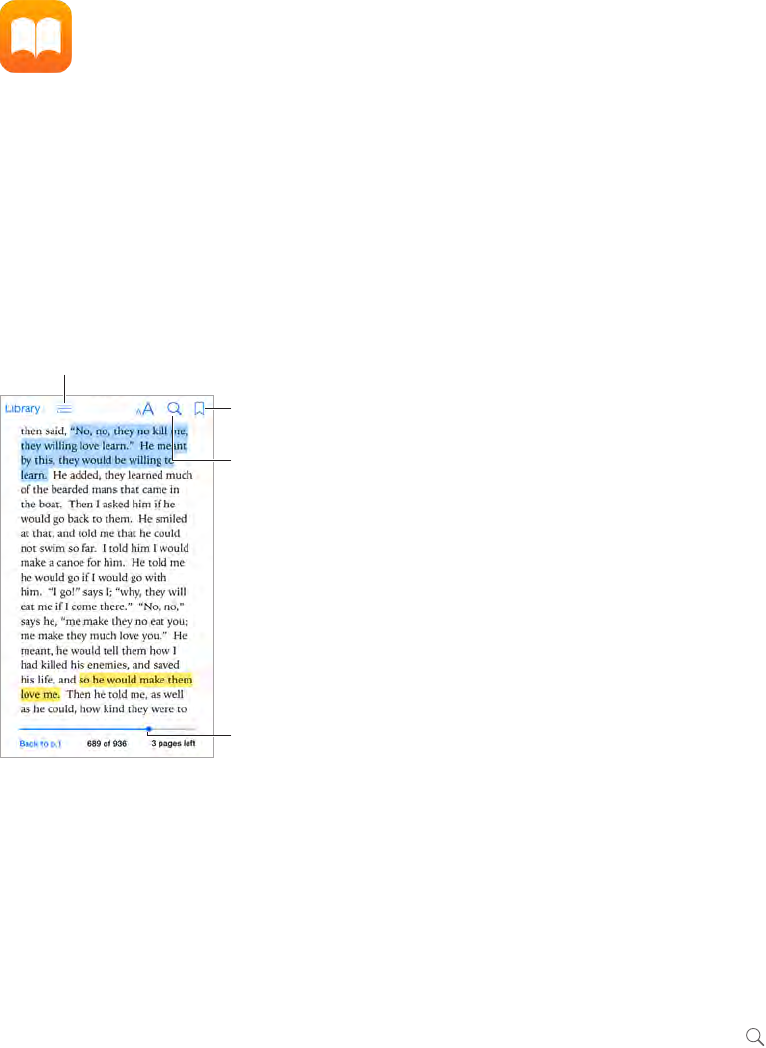
24
106
Get books
Get books from the iBooks Store. In iBooks, use the buttons at the bottom of the screen to
access the iBooks Store. Tap Featured to browse the latest releases, or Top Charts to view the
mostpopular.Tondaspecicbook,tapSearch.
Use Siri. Say, for example, “Find books by J.R.R. Tolkien.”
Read a book
Go to a page.
Go to a page.
Bookmark
this page.
Bookmark
this page.
Contents, bookmarks, and notes
Contents, bookmarks, and notes
Search in
this book.
Search in
this book.
Open a book. Tap the book you want to read. If you don’t see it on the bookshelf, swipe left or
right to see other collections.
Show the controls. Tap near the center of a page. Not all books have the same controls, but
some of the things you can do include searching, viewing the table of contents, and sharing
what you’re reading.
Close a book. Tap Library, or pinch the page.
Enlarge an image. Double-tap the image. In some books, touch and hold to display a magnifying
glass you can use to view an image.
Go to a specic page. Use the page navigation controls at the bottom of the screen. Or tap
and enter a page number, then tap the page number in the search results.
iBooks
Apple Confidential

Chapter 24 iBooks 107
Get a denition. Double-tapaword,thentapDeneinthemenuthatappears.Denitionsaren’t
available for all languages.
Remember your place. Tap to add a bookmark, or tap again to remove it. You can have
multiple bookmarks—to see them all, tap , then tap Bookmarks.You don’t need to add a
bookmarkwhenyouclosethebook,becauseiBooksrememberswhereyoulefto.
Remember the good parts. Some books let you add notes and highlights. To add a highlight,
touchandholdaword,thenmoveyourngertodrawthehighlight.Toaddanote,double-tap
a word to select it, move the grab points to adjust the selection, then tap Note in the menu that
appears.To see all the notes and highlights you’ve made, tap , then tap Notes.
Share the good parts. Tap some highlighted text, then, in the menu that appears, tap . If the
book is from the iBooks Store, a link to the book is included automatically. (Sharing may not be
available in all regions.)
Share a link to a book. Tap near the center of a page to display the controls, then tap . Tap ,
then tap Share Book.
Change the way a book looks. Some books let you change the font, font size, and color of the
page. (Tap .)YoucanchangejusticationandhyphenationinSettings>iBooks.Thesesettings
apply to all books that support them.
Page color
Page color
Brightness
Brightness
Turn off pagination.
Turn off pagination.
Change the brightness. Tap . If you don’t see , tap rst.
Dim the screen when it’s dark. Turn on Auto-Night Theme to automatically change the
bookshelf, page color, and brightness when using iBooks in low-light conditions. (Not all books
support Auto-Night Theme.)
Apple Confidential

Chapter 24 iBooks 108
Organize books
Sort the list.
Sort the list.
View collections.
View collections.
View on the
iBooks Store
View on the
iBooks Store
View books by title or by cover. Tap or .
Organize your books with collections. Tap Select, then select some books to move them into a
collection. To edit or create collections, tap the name of the current collection (at the top of the
screen). Some built-in collections, such as PDFs, can’t be renamed or deleted.
Rearrange books. While viewing books by cover, touch and hold a cover, then drag it to a new
location. While viewing books by title, sort the list using the buttons at the top of the screen. The
All Books collection is automatically arranged for you; switch to another collection if you want to
manually arrange your books.
Search for a book. PulldowntorevealtheSearcheldatthetopofthescreen.Searchinglooks
for the title and the author’s name.
Hide purchased books you haven’t downloaded. Tap the name of the current collection (at the
top of the screen), then turn on Hide iCloud Books.
Read PDFs
Sync a PDF. On a Mac, add the PDF to iBooks for OS X, open iTunes, select the PDF, then sync. In
iTunes on your Windows computer, choose File > Add to Library, select the PDF, then sync. See
iTunes Help for more info about syncing.
Add a PDF email attachment to iBooks. Open the email message, then touch and hold its PDF
attachment. Choose Open in iBooks from the menu that appears.
Print a PDF. With the PDF open, tap , then choose Print. You’ll need an AirPrint-compatible
printer. For more about AirPrint, see AirPrint on page 35.
Email a PDF. With the PDF open, tap , then choose Email.
iBooks settings
Go to Settings > iBooks, where you can:
•Sync collections and bookmarks (including notes and current page information) with your
other devices.
•Display online content within a book. Some books might access video or audio that’s stored
on the web.
Apple Confidential
Chapter 24 iBooks 109
•Change the direction pages turn when you tap in the left margin.
Apple Confidential

25
110
Your health at a glance
UsetheHealthapptokeeptrackofyourhealthandtnessinformation.Enterdataforkey
parameters, or let the Health app collect data from other apps and devices that monitor your
healthandactivity.Youcanevensharespecicdatawithselectedapps,andthroughappswith
some health care providers.
WARNING: iPod touch and the Health app are not medical devices, see Important safety
information on page 150.
Tap any item to
see details.
Tap any item to
see details.
See all available data,
control data sharing, or
add to the Dashboard.
See all available data,
control data sharing, or
add to the Dashboard.
View selected health
and fitness data.
View selected health
and fitness data.
Connect devices that
update your exercise
or medical status.
Connect devices that
update your exercise
or medical status.
Collect health and tness data
Enter your own data. If the parameter is in your Dashboard, just tap it there, then tap Add Data
Point. Otherwise, tap Health Data at the bottom of the screen, tap the parameter you want to
update, then tap Add Data Point.
Health
Apple Confidential
Chapter 25 Health 111
Collect data from a device. Follow the instructions that can come with the device to set it up. If
it’s a Bluetooth device, you need to pair it with iPod touch—see Bluetooth devices on page 36.
Collect data from an app. Follow the instructions that can come with the app to set it up, then
watch for a sharing request where you control whether data is shared with the Health app.
Stop app data collection. Tap Sources at the bottom of the Health screen, then select the app
from the Apps list. Or tap the associated parameter in your Dashboard or in the Health Data list,
tap Share Data, then choose the app under Data Sources.
Share health and tness data
Share data. Follow the instructions that come with the app or the device to set it up, then watch
for a sharing request where you control whether data is shared by the Health app. For example,
your health care provider might provide an app that sends blood pressure updates to your
doctor. You need only install the app, then allow the Health app to share blood pressure data
when prompted.
Stop sharing data. Tap Sources at the bottom of the Health screen, then select the app from the
Apps list. Or tap the associated parameter in your Dashboard or in the Health Data list, tap Share
Data, then choose the app under Share Data With.
Apple Confidential

26
112
Passbook at a glance
Use Passbook to keep your boarding passes, movie tickets, coupons, loyalty cards, and more,
allinoneplace.ScanapassoniPodtouchtocheckinforaight,getintoamovie,orredeem
acoupon.Passescanincludeusefulinformation,suchasthebalanceonyourcoeecard,a
coupon’s expiration date, or your seat number for a concert.
Tap a pass to view it.
Tap a pass to view it.
Tap to add a pass.
Tap to add a pass.
Passbook on the go
Find apps that support Passbook. Tap Apps for Passbook on the Welcome pass. Or, on your
computer, go to www.itunes.com/passbookapps/. Add a pass from an app, an email or a
Messages message, or a website when you make a purchase or receive a coupon or gift. Usually,
you tap or click the pass or the link to a pass to add it to Passbook. You can also scan codes,
which are then downloaded to Passbook, from merchants’ ads or receipts.
Scan a code. Tap , then tap Scan Code. Point your iPod touch at the code and frame it to add
the pass.
Tap to view
scanning options.
Tap to view
scanning options.
Passbook
Apple Confidential

Chapter 26 Passbook 113
Use a pass. If an alert for a pass appears on the Lock screen, slide the alert to display the pass. Or
open Passbook, select the pass, then present the barcode on the pass to the scanner.
Share a pass. You can share a pass using Mail, Messages, or AirDrop. See Share from apps on
page 32.
Display a pass based on location. A pass can appear on the Lock screen when you wake
iPodtouchattherighttimeorplace—forexample,whenyoureachtheairportforaightyou’re
taking. Location Services must be turned on in Settings > Privacy > Location Services.
Rearrange passes. Drag a pass in the list to move it to a new location. The pass order is updated
on all your iOS 7 or later devices.
Refresh a pass. Passes are usually updated automatically. To refresh a pass manually, tap the pass,
tap , then pull the pass downward.
Use iTunes Pass. You can add an iTunes Pass to Passbook, which makes it easy to add money to
your Apple ID so you can make purchases from the iTunes Store, App Store, and iBooks Store
without using a credit or debit card. To add your iTunes Pass, go to App Store > Redeem, then
tap Get Started under iTunes Pass. You can add money to your iTunes Pass at Apple Retail Stores
in most countries.
Done with a pass? Tap the pass, tap , then tap Delete.
Passbook settings
Keep passes from appearing on the Lock screen. Go to Settings > Passcode, then tap Turn
PasscodeOn.Then,underAllowAccessWhenLocked,turnoPassbook.Forpasseswith
notications,tokeepaspecicpassfromappearingontheLockscreen,tapthepass,tap ,
thenturnoShowOnLockScreen.
Set notication options. GotoSettings>Notications>Passbook.
Include passes on your other iOS devices. Go to Settings > iCloud, then turn on Passbook.
Apple Confidential
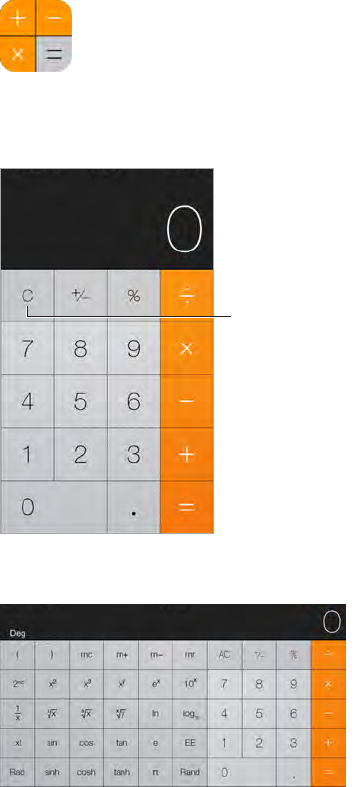
27
114
Tap numbers and functions in Calculator, just as you would with a standard calculator.
Get to Calculator quickly! Swipe up from the bottom edge of the screen to open Control Center.
Clear the display.
Clear the display.
Tousethescienticcalculator,rotateiPodtouchtolandscapeorientation.
Calculator
Apple Confidential
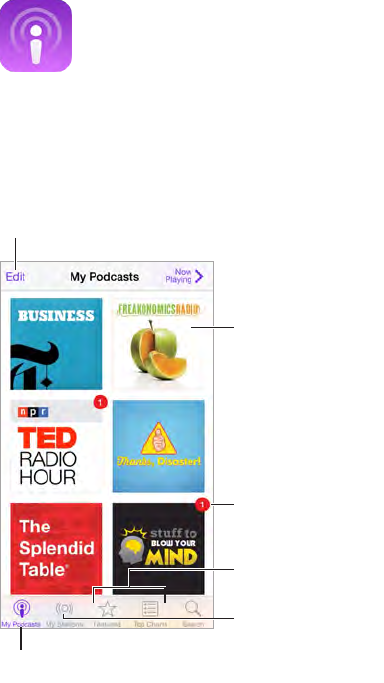
28
115
Podcasts at a glance
Open the Podcasts app, then browse, subscribe to, and play your favorite audio or video podcasts
on iPod touch.
See your subscriptions
and downloaded podcasts.
See your subscriptions
and downloaded podcasts.
Delete or rearrange podcasts.
Delete or rearrange podcasts.
Tap a podcast to
view and play
episodes.
Tap a podcast to
view and play
episodes.
Organize and
automatically update
your favorites.
Organize and
automatically update
your favorites.
Browse for podcasts.
Browse for podcasts.
New episodes
New episodes
Get podcasts and episodes
Discover more podcasts. Tap Featured or Top Charts at the bottom of the screen.
Search for new podcasts. Tap Search at the bottom of the screen.
Search your library. Tap My Podcasts, then drag down the center of the screen to reveal the
Searcheld.
Podcasts
Apple Confidential

Chapter 28 Podcasts 116
Preview or stream an episode. Tap the podcast, then tap an episode.
Pull down to see
Edit, Settings, and
Share options.
Pull down to see
Edit, Settings, and
Share options.
View unplayed
episodes.
View unplayed
episodes.
View available
episodes.
View available
episodes.
Get more info. Tap to get episode details. Tap any link in podcast or episode descriptions to
open them in Safari.
Find new episodes. TapUnplayedtondepisodesyouhaven’tyetheard.
Browse episodes. Tap Feed to see episodes available to download or stream.
Download an episode to iPod touch. Tap next to the episode.
Get new episodes as they're released. Subscribe to the podcast. If you’re browsing Featured
podcasts or Top Charts, tap the podcast, then tap Subscribe. If you’ve already downloaded
episodes, tap My Podcasts, tap the podcast, tap Settings at the top of the episode list, then turn
on Subscription.
Save episodes. Tap next to an episode, then tap Save Episode. Tap Delete Download to delete
a saved episode.
Apple Confidential

Chapter 28 Podcasts 117
Control playback
Use the playback controls to go forward and back in a podcast, set the speed, skip episodes,
and more.
See a list of
episodes.
See a list of
episodes.
Tap to see
more info.
Tap to see
more info.
Drag to skip
forward or back.
Drag to skip
forward or back.
Skip to the next
episode.
Skip to the next
episode.
Tap to speed up
or slow down.
Tap to speed up
or slow down.
Tap to start over, or
double-tap to go to the
previous episode.
Tap to start over, or
double-tap to go to the
previous episode.
See podcast info while you listen. Tap the podcast image on the Now Playing screen.
Skip forward or back with greater accuracy. Moveyourngertowardthetopofthescreenas
you drag the playhead left or right. When you’re close to the playback controls, you can scan
quickly through the entire episode. When you’re close to the top of the screen, you can scan one
second at a time.
Use Siri.Say something like:
•“Play podcasts”
•“Play it twice as fast”
•"Skip ahead 10 seconds”
Apple Confidential
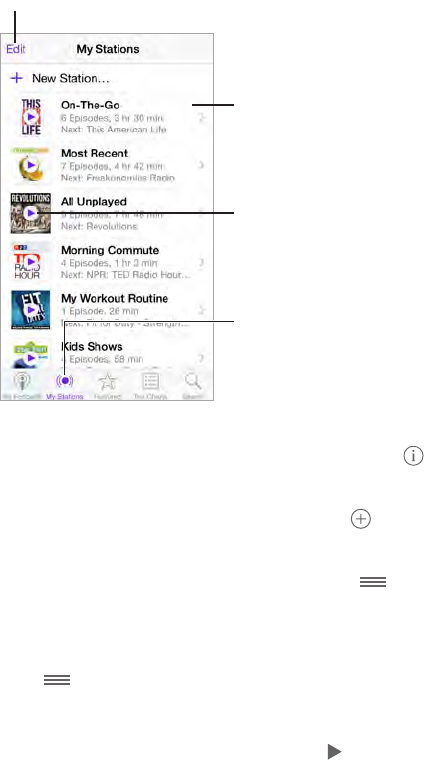
Chapter 28 Podcasts 118
Organize your favorites into stations
Organize your favorite podcasts into custom stations, and update episodes automatically across
all your devices.
Organize selected
podcasts and
episodes into
stations.
Organize selected
podcasts and
episodes into
stations.
Tap a station to
choose episodes or
change settings.
Tap a station to
choose episodes or
change settings.
Tap to play the
latest episode.
Tap to play the
latest episode.
Delete or rearrange stations.
Delete or rearrange stations.
Pull together episodes from dierent podcasts. To add episodes to your On-The-Go station, tap
My Stations, tap On-The-Go, then tap Add. Or tap next to any episode in your library. You can
also touch and hold any episode, then tap Add to On-The-Go.
Create a station. Tap My Stations, then tap .
Change the order of the station list or the podcasts in a station. Tap My Stations, tap Edit above
the station list or the episode list, then drag up or down.
Change the playback order for episodes in a station. Tap the station, then tap Settings.
Rearrange your podcast library. Tap My Podcasts, tap list view in the upper right, tap Edit, then
drag up or down.
List oldest episodes rst. Tap My Podcasts, tap a podcast, then tap Settings.
Play podcasts from the station list. Tap next to the station name.
Podcasts settings
Go to Settings > Podcasts, where you can:
•Choose to keep your podcast subscriptions up to date on all your devices.
•Choose how frequently Podcasts checks your subscriptions for new episodes.
•Have episodes downloaded automatically.
•Choosewhethertokeepepisodesafteryounishthem.
Apple Confidential

29
119
Voice Memos at a glance
Voice Memos lets you use iPod touch as a portable recording device. Use it with the built-in
microphone, or a supported headset or external microphone.
Drag recording
level to position
play/record head.
Drag recording
level to position
play/record head.
Record, pause,
or resume.
Record, pause,
or resume.
Trim the recording.
Trim the recording.
Switch playback
between receiver
and speaker.
Switch playback
between receiver
and speaker.
Save the recording.
Save the recording.
Your recordings
Your recordings
Listen before saving.
Listen before saving.
Record
Make a recording. Tap or press the center button on your headset. Tap again to pause
or resume.
Recordings using the built-in microphone are mono, but you can record stereo using an external
stereo microphone that works with the iPod touch headphones port or the Lightning connector.
Look for accessories marked with the Apple “Made for iPod” or “Works with iPod” logo.
Adjust the recording level. Move the microphone closer to what you’re recording. For better
recording quality, the loudest level should be between –3 dB and 0 dB.
Preview before saving. Tap to the left of the Record button. To position the play head, drag
the recording level display left or right.
Record over a section. Drag the recording level display to position the record/play head, then
tap .
Voice Memos
Apple Confidential

Chapter 29 Voice Memos 120
Trim the excess. Tap , then drag the red trim handles. Tap to check your edit. Adjust the trim
handlesifnecessary,thentapTrimwhenyou’renished.
Save the recording. Tap Done.
Mute the start and stop tones. Use the iPod touch volume buttons to turn the volume all the
way down.
Multitask. To use another app while you’re recording, press the Home button, then open the
other app. To return to Voice Memos, tap the red bar at the top of the screen.
Play it back
Trim or rename the
recording.
Trim or rename the
recording.
Listen to the recording.
Listen to the recording.
Tap a recording to play or edit it.
Tap a recording to play or edit it.
Drag to skip ahead
or rewind.
Drag to skip ahead
or rewind.
Rename a recording. Tap the name of the recording.
Move recordings to your computer
You can sync voice memos with the iTunes library on your computer, and listen to them on your
computer or sync them with another iPod touch or iPhone.
When you delete a synced voice memo from iTunes, it stays on the device where it was recorded,
but it’s deleted from any other iPod touch or iPhone you synced. If you delete a synced voice
memo on iPod touch, it’s copied back to iPod touch the next time you sync with iTunes, but you
can’t sync that copy back to iTunes a second time.
Sync voice memos with iTunes. Connect iPod touch to your computer. Open iTunes on your
computer, then select iPod touch. Select Music at the top of the screen, select Sync Music, select
“Include voice memos,” then click Apply.
Voice memos synced from iPod touch to your computer appear in the Music list and in the Voice
Memos playlist in iTunes. Voice memos synced from your computer appear in the Voice Memos
app on iPod touch, but not in the Music app.
Apple Confidential
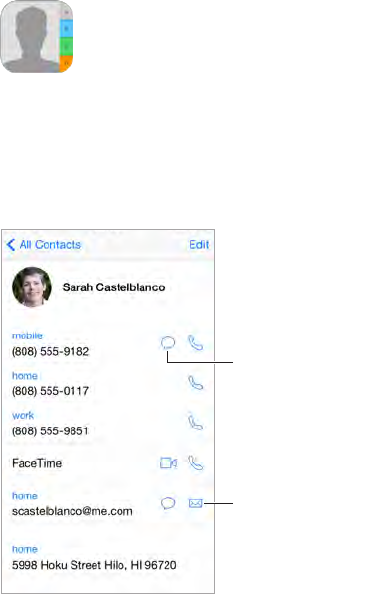
30
121
Contacts at a glance
iPod touch lets you access and edit your contacts list from personal, business, and
other accounts.
Open in Mail.
Open in Mail.
Open in Messages.
Open in Messages.
Set your My Info card for Safari, Siri, and other apps. Go to Settings > Mail, Contacts, Calendars,
tap My Info, then select the contact card with your name and information.
Let Siri know who’s who. Onyourcontactcard,useAddRelatedNamestodenerelationships
you want Siri to know about, so you can say things like “send a message to my sister.”
Use Siri. Say, for example, “Jimmy Manning is my brother.”
Find a contact. Tapthesearcheldatthetopofthecontactslist,thenenteryoursearch.Youcan
also search your contacts using Spotlight Search (see Spotlight Search on page 29).
Use Siri. Say, for example, “What’s my brother’s work address?”
Share a contact. Tap a contact, then tap Share Contact. See Share from apps on page 32.
Change a label. Ifaeldhasthewronglabel,suchasHomeinsteadofWork,tapEdit.Thentap
the label and choose one from the list, or tap Custom Field to create one of your own.
Add your friends’ social proles. Whileviewingacontact,tapEdit,thentap“addsocialprole.”
You can add Twitter, Facebook, LinkedIn, Flickr, Myspace, and Sina Weibo accounts, or create a
custom entry.
Delete a contact. Go to the contact’s card, then tap Edit. Scroll down, then tap Delete Contact.
Contacts
Apple Confidential
Chapter 30 Contacts 122
Add contacts
Besides entering contacts, you can:
•Use your iCloud contacts: Go to Settings > iCloud, then turn on Contacts.
•Import your Facebook Friends: Go to Settings > Facebook, then turn on Contacts in the “Allow
These Apps to Use Your Accounts” list. This creates a Facebook group in Contacts.
•Use your Google contacts: Go to Settings > Mail, Contacts, Calendars, tap your Google account,
then turn on Contacts.
•Access a Microsoft Exchange Global Address List: Go to Settings > Mail, Contacts, Calendars, tap
your Exchange account, then turn on Contacts.
•Set up an LDAP or CardDAV account to access business or school directories: Go to Settings > Mail,
Contacts, Calendars > Add Account > Other. Tap Add LDAP account or Add CardDAV account,
then enter the account information.
•Sync contacts from your computer: In iTunes on your computer, turn on contact syncing in the
device info pane. For information, see iTunes Help.
•Import contacts from a vCard: Tap a .vcf attachment in an email or message.
Search a directory. Tap Groups, tap the GAL, CardDAV, or LDAP directory you want to search,
then enter your search. To save a person’s info to your contacts, tap Add Contact.
Show or hide a group. Tap Groups, then select the groups you want to see. This button appears
only if you have more than one source of contacts.
Update your contacts using Twitter, Facebook, and Sina Weibo. Go to Settings > Twitter,
Settings > Facebook, or Settings > Sina Weibo, then tap Update Contacts. This updates contact
photos and social media account names in Contacts.
Unify contacts
When you have contacts from multiple sources, you might have multiple entries for the same
person. To keep redundant contacts from appearing in your All Contacts list, contacts from
dierentsourcesthathavethesamenamearelinkedanddisplayedasasingleunied contact.
Whenyouviewauniedcontact,thetitleUniedInfoappears.
Link contacts. If two entries for the same person aren’t linked automatically, you can unify them
manually. Edit one of the contacts, tap Edit, tap Link Contact, then choose the other contact entry
to link to.
Ifyoulinkcontactswithdierentrstorlastnames,thenamesontheindividualcardswon’t
change,butonlyonenameappearsontheuniedcard.Tochoosewhichnameappearswhen
youviewtheuniedcard,tapEdit,tapthelinkedcardwiththenameyouprefer,thentapUse
ThisNameForUniedCard.
Contacts settings
Go to Settings > Mail, Contacts, Calendars, where you can:
•Change how contacts are sorted
•Displaycontactsbyrstorlastname
•Change how long names are shortened in lists
•Choose to show recent contacts in the multitasking screen
•Set a default account for new contacts
Apple Confidential
Chapter 30 Contacts 123
•Set your My Info card
Apple Confidential
A
124
Accessibility features
iPodtouchoersmanyaccessibilityfeatures:
Vision
•VoiceOver
•Support for braille displays
•Zoom
•Invert Colors and Grayscale
•Speak Selection
•Speak Screen
•Speak Auto-text
•Large, bold, and high-contrast text
•Button Shapes
•Reduce screen motion
•On/oswitchlabels
•Assignable tones
•Video Descriptions
Hearing
•Hearing aids
•Mono audio and balance
•Subtitles and closed captions
Interaction
•Siri
•Widescreen keyboards
•Guided Access
•Switch Control
•AssistiveTouch
Turn on accessibility features. Go to Settings > General > Accessibility, or use the Accessibility
Shortcut. See Accessibility Shortcut on page 125.
With your voice, you can also use Siri to open apps, invert colors, read the screen in some apps,
and work with VoiceOver. See Chapter 4, Siri, on page 41.
Use iTunes on your computer to congure accessibility on iPod touch. You can choose some
accessibility options in iTunes on your computer. Connect iPod touch to your computer, then
selectiPodtouchintheiTunesdevicelist.ClickSummary,thenclickCongureAccessibilityatthe
bottom of the Summary screen.
Accessibility
Appendix
Apple Confidential
Appendix A Accessibility 125
For more information about iPod touch accessibility features, see www.apple.com/accessibility.
Accessibility Shortcut
Use the Accessibility Shortcut. Press the Home button quickly three times to turn any of these
featuresonoro:
•VoiceOver
•Invert Colors
•Grayscale
•Zoom
•Switch Control
•AssistiveTouch
•Guided Access (The shortcut starts Guided Access if it’s already turned on. See Guided
Access on page 140.)
•Hearing Aid Control (if you have paired Made for iPhone hearing aids)
Choose the features you want to control. Go to Settings > General > Accessibility > Accessibility
Shortcut, then select the accessibility features you use.
Not so fast. To slow down the triple-click speed, go to Settings > General > Accessibility > Home-
click Speed. (This also slows down double-clicks.)
VoiceOver
VoiceOver describes aloud what appears onscreen, so you can use iPod touch without seeing it.
VoiceOver tells you about each item on the screen as you select it. The VoiceOver cursor (a
rectangle) encloses the item and VoiceOver speaks its name or describes it.
Touchthescreenordragyourngeroverittoheartheitemsonthescreen.Whenyouselect
text, VoiceOver reads the text. If you turn on Speak Hints, VoiceOver may tell you the name of the
item and provide instructions—for example, “double-tap to open.” To interact with items, such as
buttons and links, use the gestures described in Learn VoiceOver gestures on page 128.
Whenyougotoanewscreen,VoiceOverplaysasound,thenselectsandspeakstherstitem
of the screen (typically in the upper-left corner). VoiceOver also lets you know when the display
changes to landscape or portrait orientation, and when the screen becomes dimmed or locked.
Note: VoiceOverspeaksinthelanguagespeciedinSettings>General>Language&Region.
VoiceOver is available in many languages, but not all.
VoiceOver Basics
Important: VoiceOver changes the gestures you use to control iPod touch. When VoiceOver is on,
youmustuseVoiceOvergesturestooperateiPodtouch—eventoturnVoiceOvero.
Turn VoiceOver on or o. Go to Settings > General > Accessibility > VoiceOver, or use the
Accessibility Shortcut. See Accessibility Shortcut above.
Use Siri. Say:
•"Turn VoiceOver on.”
•"TurnVoiceOvero.”
Apple Confidential
Appendix A Accessibility 126
Explore. Dragyourngeroverthescreen.VoiceOverspeakseachitemyoutouch.Liftyournger
to leave an item selected.
•Select an item: Tapit,orliftyourngerwhiledraggingoverit.
•Select the next or previous item: Swiperightorleftwithonenger.Itemorderisleft-to-right,
top-to-bottom.
•Select the item above or below: Set the rotor to Vertical Navigation, then swipe up or down
withonenger.Ifyoudon’tndVerticalNavigationintherotor,youcanaddit;seeUse the
VoiceOver rotor on page 129.
•Select the rst or last item on the screen: Tapwithfourngersatthetoporbottomof
the screen.
•Select an item by name: Triple-tapwithtwongersanywhereonthescreentoopentheItem
Chooser.Thentypeanameinthesearcheld,orswiperightorlefttomovethroughthelist
alphabetically, or tap the table index to the right of the list and swipe up or down to move
quickly through the list of items. You can also use handwriting to select an item by writing its
name; see Writewithyournger on page 131. To dismiss the Item Chooser without making a
selection,doatwo-ngerscrub(movetwongersbackandforththreetimesquickly,making
a “z”).
•Change an item’s name so it’s easier to nd: Select the item, then double-tap and hold with two
ngersanywhereonthescreen.
•Speak the text of the selected item: Set the rotor to characters or words, then swipe down or up
withonenger.
•Turn spoken hints on or o: Go to Settings > General > Accessibility > VoiceOver > Speak Hints.
•Use phonetic spelling: Go to Settings > General > Accessibility > VoiceOver >
Phonetic Feedback.
•Speak the entire screen, from the top: Swipeupwithtwongers.
•Speak from the current item to the bottom of the screen: Swipedownwithtwongers.
•Pause speaking: Taponcewithtwongers.Tapagainwithtwongerstoresume,orselect
another item.
•Mute VoiceOver: Double-tapwiththreengers;repeattounmute.Ifyou’reusinganexternal
keyboard, press the Control key.
•Silence sound eects: GotoSettings>General>Accessibility>VoiceOver,thenturnoUse
SoundEects.
Use a larger VoiceOver cursor. Go to Settings > General > Accessibility > VoiceOver, then turn on
Large Cursor.
Adjust the speaking voice. You can adjust the VoiceOver speaking voice:
•Change the volume: Use the volume buttons on iPod touch. You can also add volume to the
rotor, then swipe up and down to adjust; see Use the VoiceOver rotor on page 129.
•Change the speech rate: Go to Settings > General > Accessibility > VoiceOver, then drag
the Speaking Rate slider. You can also set the rotor to Speech Rate, then swipe up or down
to adjust.
•Use pitch change: VoiceOverusesahigherpitchwhenspeakingtherstitemofagroup(such
as a list or table) and a lower pitch when speaking the last item of a group. Go to Settings >
General > Accessibility > VoiceOver > Use Pitch Change.
•Speak punctuation: Set the rotor to Punctuation, then swipe up or down to select how much
you want to hear.
Apple Confidential

Appendix A Accessibility 127
•Control audio ducking: To choose whether audio that’s playing is turned down while VoiceOver
speaks, set the rotor to Audio Ducking, then swipe up or down.
•Change the language for iPod touch: Go to Settings > General > Language & Region. VoiceOver
pronunciationofsomelanguagesisaectedbytheRegionFormatyouchoosethere.
•Change pronunciation: Set the rotor to Language, then swipe up or down. Language is
available in the rotor only if you add a language at Settings > General > Accessibility >
VoiceOver > Speech > Rotor Languages.
•Choose which dialects are available in the rotor: Go to Settings > General > Accessibility >
VoiceOver > Speech > Rotor Languages. To adjust voice quality or speaking rate, tap next
to the language. To remove languages from the rotor or change their order, tap Edit, tap the
delete button or drag up or down, then tap Done.
•Set the default dialect for the current iPod touch language: Go to Settings > General >
Accessibility > VoiceOver > Speech.
•Download an enhanced quality reading voice: Go to Settings > General > Accessibility >
VoiceOver > Speech, tap a language, then tap Enhanced Quality. If you’re using English, you
can choose to download Alex (869 MB), the same high-quality U.S. English voice used for
VoiceOver on Mac computers.
Use iPod touch with VoiceOver
Unlock iPod touch. Press either the Home button or the Sleep/Wake button, swipe to select the
Unlock button, then double-tap the screen.
Enter your passcode silently. To avoid having your passcode spoken as you enter it, use
handwriting; see Writewithyournger on page 131.
Open an app, toggle a switch, or tap an item. Select the item, then double-tap the screen.
Double-tap the selected item. Triple-tap the screen.
Adjust a slider. Selecttheslider,thenswipeupordownwithonenger.
Use a standard gesture. Double-tapandholdyourngeronthescreenuntilyouhearthree
risingtones,thenmakethegesture.Whenyouliftyournger,VoiceOvergesturesresume.For
example,todragavolumesliderwithyourngerinsteadofswipingupanddown,selectthe
slider, double-tap and hold, wait for the three tones, then slide left or right.
Scroll a list or area of the screen. Swipeupordownwiththreengers.
•Scroll continuously through a list: Double-tap and hold until you hear three rising tones, then
drag up or down.
•Use the list index: Some lists have an alphabetical table index along the right side. Select the
index, then swipe up or down to move through the index. You can also double-tap, hold, then
slideyourngerupordown.
•Reorder a list: You can change the order of items in some lists, such as the Rotor items in
Accessibility settings. Select to the right of an item, double-tap and hold until you hear
three rising tones, then drag up or down.
Open Notication Center. Selectanyiteminthestatusbar,thenswipedownwiththreengers.
TodismissNoticationCenter,doatwo-ngerscrub(movetwongersbackandforththree
times quickly, making a “z”).
Open Control Center. Selectanyiteminthestatusbar,thenswipeupwiththreengers.To
dismissControlCenter,doatwo-ngerscrub.
Apple Confidential
Appendix A Accessibility 128
Switch apps. Double-clicktheHomebuttontoseeopenapps,swipeleftorrightwithonenger
to select an app, then double-tap to switch to it. Or, set the rotor to Actions while viewing open
apps, then swipe up or down.
Rearrange your Home screen. Select an icon on the Home screen, double-tap and hold, then
drag.Liftyourngerwhentheiconisinitsnewlocation.Draganicontotheedgeofthescreen
to move it to another Home screen. You can continue to select and move items until you press
the Home button.
Speak iPod touch status information. Tap the status bar at the top of the screen, then swipe left
or right to hear information about the time, battery state, Wi-Fi signal strength, and more.
Speak notications. Go to Settings > General > Accessibility > VoiceOver, then turn on Always
SpeakNotications.Notications,includingthetextofincomingtextmessages,arespokenas
theyoccur,evenifiPodtouchislocked.Unacknowledgednoticationsarerepeatedwhenyou
unlock iPod touch.
Turn the screen curtain on or o. Triple-tapwiththreengers.Whenthescreencurtainison,the
screencontentsareactiveeventhoughthedisplayisturnedo.
Learn VoiceOver gestures
WhenVoiceOverison,standardtouchscreengestureshavedierenteects,andadditional
gestures let you move around the screen and control individual items. VoiceOver gestures
includetwo-,three-,andfour-ngertapsandswipes.Forbestresultsusingmulti-ngergestures,
relaxandletyourngerstouchthescreenwithsomespacebetweenthem.
YoucanusedierenttechniquestoperformVoiceOvergestures.Forexample,youcanperform
atwo-ngertapusingtwongersononehand,oronengeroneachhand.Youcanevenuse
your thumbs. Some people use a split-tap gesture: instead of selecting an item and double-
tapping,touchandholdanitemwithonenger,thentapthescreenwithanothernger.
Trydierenttechniquestodiscoverwhichworksbestforyou.Ifagesturedoesn’twork,trya
quicker movement, especially for a double-tap or swipe gesture. To swipe, try brushing the
screenquicklywithyourngerorngers.
In VoiceOver settings, you can enter a special area where you can practice VoiceOver gestures
withoutaectingiPodtouchoritssettings.
Practice VoiceOver gestures. Go to Settings > General > Accessibility > VoiceOver, then tap
VoiceOverPractice.Whenyounishpracticing,tapDone.Ifyoudon’tseetheVoiceOverPractice
button, make sure VoiceOver is turned on.
Here are some key VoiceOver gestures:
Navigate and read
•Tap: Select and speak the item.
•Swipe right or left: Select the next or previous item.
•Swipe up or down: Depends on the rotor setting. See Use the VoiceOver rotor on page 129.
•Two-nger swipe up: Read all from the top of the screen.
•Two-nger swipe down: Read all from the current position.
•Two-nger tap: Stop or resume speaking.
•Two-nger scrub: Movetwongersbackandforththreetimesquickly(makinga“z”)todismiss
an alert or go back to the previous screen.
•Three-nger swipe up or down: Scroll one page at a time.
Apple Confidential

Appendix A Accessibility 129
•Three-nger swipe right or left: Go to the next or previous page (on the Home screen, for
example).
•Three-nger tap: Speak additional information, such as position within a list or whether text
is selected.
•Four-nger tap at top of screen: Selecttherstitemonthepage.
•Four-nger tap at bottom of screen: Select the last item on the page.
Activate
•Double-tap: Activate the selected item.
•Triple-tap: Double-tap an item.
•Split-tap: As an alternative to selecting an item and double-tapping to activate it, touch and
holdanitemwithonenger,thentapthescreenwithanother.
•Double-tap and hold (1 second) + standard gesture: Use a standard gesture. The double-tap and
hold gesture tells iPod touch to interpret the next gesture as standard. For example, you can
double-tapandhold,andthenwithoutliftingyournger,dragyourngertoslideaswitch.
•Two-nger double-tap: Play or pause in Music, Videos, Voice Memos, or Photos. Take a photo in
Camera. Start or pause recording in Camera or Voice Memos. Start or stop the stopwatch.
•Two-nger double-tap and hold: Changeanitem’slabeltomakeiteasiertond.
•Two-nger triple-tap: Open the Item Chooser.
•Three-nger double-tap: Mute or unmute VoiceOver.
•Three-nger triple-tap: Turnthescreencurtainonoro.
Use the VoiceOver rotor
Use the rotor to choose what happens when you swipe up or down with VoiceOver turned on, or
to select special input methods such as Braille Screen Input or Handwriting.
Operate the rotor. Rotatetwongersonthescreenaroundapointbetweenthem.
Choose your rotor options. Go to Settings > General > Accessibility > VoiceOver > Rotor, then
select the options you want to include in the rotor.
Theavailablerotoroptionsandtheireectsdependonwhatyou’redoing.Forexample,ifyou’re
reading an email, you can use the rotor to switch between hearing text spoken word-by-word or
character-by-character when you swipe up or down. If you’re browsing a webpage, you can set
the rotor to speak all the text (either word-by-word or character-by-character), or to jump from
one item to another of a certain type, such as headers or links.
When you use an Apple Wireless Keyboard to control VoiceOver, the rotor lets you adjust settings
such as volume, speech rate, use of pitch or phonetics, typing echo, and reading of punctuation.
See Use VoiceOver with an Apple Wireless Keyboard on page 132.
Use the onscreen keyboard
Whenyouactivateaneditabletexteld,theonscreenkeyboardappears(unlessyouhavean
Apple Wireless Keyboard attached).
Apple Confidential

Appendix A Accessibility 130
Activate a text eld. Selectthetexteld,thendouble-tap.Theinsertionpointandtheonscreen
keyboard appear.
Enter text. Type characters using the onscreen keyboard:
•Standard typing: Select a key on the keyboard by swiping left or right, then double-tap to
enterthecharacter.Ormoveyourngeraroundthekeyboardtoselectakeyand,while
continuingtotouchthekeywithonenger,tapthescreenwithanothernger.VoiceOver
speaks the key when it’s selected, and again when the character is entered.
•Touch typing: Touchakeyonthekeyboardtoselectit,thenliftyourngertoenterthe
character.Ifyoutouchthewrongkey,slideyourngertothekeyyouwant.VoiceOver
speaks the character for each key as you touch it, but doesn’t enter a character until you lift
yournger.
•Direct Touch typing: VoiceOver is disabled for the keyboard only, so you can type just as you do
whenVoiceOveriso.
•Choose typing style: Go to Settings > General > Accessibility > VoiceOver > Typing Style. Or set
the rotor to Typing Mode, then swipe up or down.
Move the insertion point. Swipe up or down to move the insertion point forward or backward in
the text. Use the rotor to choose whether you want to move the insertion point by character, by
word, or by line. To jump to the beginning or end, double-tap the text.
VoiceOver makes a sound when the insertion point moves, and speaks the character, word, or
line that the insertion point moves across. When moving forward by words, the insertion point
is placed at the end of each word, before the space or punctuation that follows. When moving
backward, the insertion point is placed at the end of the preceding word, before the space or
punctuation that follows it.
Move the insertion point past the punctuation at the end of a word or sentence. Use the rotor
to switch back to character mode.
When moving the insertion point by line, VoiceOver speaks each line as you move across it.
When moving forward, the insertion point is placed at the beginning of the next line (except
when you reach the last line of a paragraph, when the insertion point is moved to the end of the
line just spoken). When moving backward, the insertion point is placed at the beginning of the
line that’s spoken.
Change typing feedback. Go to Settings > General > Accessibility > VoiceOver >
Typing Feedback.
Use phonetics in typing feedback. Go to Settings > General > Accessibility > VoiceOver >
PhoneticFeedback.Textisreadcharacterbycharacter.VoiceOverrstspeaksthecharacter,then
its phonetic equivalent—for example, “f” and then “foxtrot.”
Delete a character. Use with any of the VoiceOver typing styles. VoiceOver speaks each
character as it’s deleted. If Use Pitch Change is turned on, VoiceOver speaks deleted characters in
a lower pitch.
Select text. Set the rotor to Edit, swipe up or down to choose Select or Select All, then double-
tap. If you choose Select, the word closest to the insertion point is selected when you double-
tap.Toincreaseordecreasetheselection,doatwo-ngerscrubtodismissthepop-upmenu,
then pinch.
Cut, copy, or paste. Set the rotor to Edit, select the text, swipe up or down to choose Cut, Copy,
or Paste, then double-tap.
Undo. Shake iPod touch, swipe left or right to choose the action to undo, then double-tap.
Apple Confidential
Appendix A Accessibility 131
Enter an accented character. In standard typing style, select the plain character, then double-tap
and hold until you hear a sound indicating alternate characters have appeared. Drag left or right
toselectandhearthechoices.Releaseyourngertoenterthecurrentselection.Intouchtyping
style, touch and hold a character until the alternate characters appear.
Change the keyboard language. Set the rotor to Language, then swipe up or down. Choose
“defaultlanguage”tousethelanguagespeciedinLanguage&Regionsettings.TheLanguage
rotor item appears only if you select more than one language in Settings > General >
Accessibility > VoiceOver > Speech.
Write with your nger
Handwritingmodeletsyouentertextbywritingcharactersonthescreenwithyournger.In
addition to normal text entry, use handwriting mode to enter your iPod touch passcode silently
or open apps from the Home screen.
Enter handwriting mode. Use the rotor to select Handwriting. If Handwriting isn’t in the rotor, go
to Settings > General > Accessibility > VoiceOver > Rotor, then add it.
Choose a character type. Swipeupordownwiththreengerstochooselowercase,numbers,
uppercase, or punctuation.
Hear the currently selected character type. Tapwiththreengers.
Enter a character. Tracethecharacteronthescreenwithyournger.
Enter a space. Swiperightwithtwongers.
Go to a new line. Swiperightwiththreengers.
Delete the character before the insertion point. Swipeleftwithtwongers.
Select an item on the Home screen. Start writing the name of the item. If there are multiple
matches,continuetospellthenameuntilit’sunique,orswipeupordownwithtwongersto
choose from the current matches.
Enter your passcode silently. Set the rotor to Handwriting on the passcode screen, then write
the characters of your passcode.
Use a table index to skip through a long list. Select the table index to the right of the table (for
example, next to your Contacts list or in the VoiceOver Item Chooser), then write the letter.
Set the rotor to a web browsing element type. Writetherstletterofapageelementtype.For
example, write “l” to have up or down swipes skip to links, or “h” to skip to headings.
Exit handwriting mode. Doatwo-ngerscrub,orturntherotortoadierentselection.
Type onscreen braille
WithBrailleScreenInputenabled,youcanuseyourngerstoenter6-dotorcontractedbraille
codesdirectlyontheiPodtouchscreen.TapcodeswithiPodtouchlayingatinfrontofyou
(tabletopmode),orholdiPodtouchwiththescreenfacingawaysoyourngerscurlbacktotap
the screen (screen away mode).
Turn on Braille Screen Input. UsetherotortoselectBrailleScreenInput.Ifyoudon’tnditinthe
rotor, go to Settings > General > Accessibility > VoiceOver > Rotor, then add it.
Enter braille codes. PlaceiPodtouchatinfrontofyouorholditwiththescreenfacingaway,
thentapthescreenwithoneorseveralngersatthesametime.
Adjust entry dot positions. Tomovetheentrydotstomatchyournaturalngerpositions,tap
andliftyourrightthreengersallatoncetopositiondots4,5,and6,followedimmediatelyby
yourleftthreengersfordots1,2,and3.
Apple Confidential
Appendix A Accessibility 132
Switch between 6-dot and contracted braille. Swipetotherightwiththreengers.Tosetthe
default, go to Settings > General > Accessibility > VoiceOver > Braille > Braille Screen Input.
Enter a space. Swiperightwithonenger.(Inscreenawaymode,swipetoyour right.)
Delete the previous character. Swipeleftwithonenger.
Move to a new line (typing). Swiperightwithtwongers.
Cycle through spelling suggestions. Swipeupordownwithonenger.
Select an item on the Home screen. Start entering the name of the item. If there are multiple
matches,continuetospellthenameuntilitisunique,orswipeupordownwithonengerto
select a partial match.
Open the selected app. Swiperightwithtwongers.
Turn braille contractions on or o. Swipetotherightwiththreengers.
Translate immediately (when contractions are enabled). Swipedownwithtwongers.
Stop entering braille. Doatwo-ngerscrub,orsettherotortoanothersetting.
Use VoiceOver with an Apple Wireless Keyboard
You can control VoiceOver using an Apple Wireless Keyboard paired with iPod touch. See Use an
Apple Wireless Keyboard on page 26.
Use VoiceOver keyboard commands to navigate the screen, select items, read screen contents,
adjust the rotor, and perform other VoiceOver actions. Most commands use the Control-Option
key combination, abbreviated in the list that follows as “VO.”
You can use VoiceOver Help to learn the keyboard layout and the actions associated with various
key combinations. VoiceOver Help speaks keys and keyboard commands as you type them,
without performing the associated action.
VoiceOver keyboard commands
VO = Control-Option
•Turn on VoiceOver Help: VO–K
•Turn o VoiceOver Help: Escape
•Select the next or previous item: VO–Right Arrow or VO–Left Arrow
•Double-tap to activate the selected item: VO–Space bar
•Press the Home button: VO–H
•Touch and hold the selected item: VO–Shift–M
•Move to the status bar: VO–M
•Read from the current position: VO–A
•Read from the top: VO–B
•Pause or resume reading: Control
•Copy the last spoken text to the clipboard: VO–Shift–C
•Search for text: VO–F
•Mute or unmute VoiceOver: VO–S
•Open Notication Center: Fn–VO–Up Arrow
•Open Control Center: Fn–VO–Down Arrow
•Open the Item Chooser: VO–I
Apple Confidential
Appendix A Accessibility 133
•Change the label of the selected item: VO–/
•Double-tap with two ngers: VO–”-”
•Adjust the rotor: Use Quick Nav (see below)
•Swipe up or down: VO–Up Arrow or VO–Down Arrow
•Adjust the speech rotor: VO–Command–Left Arrow or VO–Command–Right Arrow
•Adjust the setting specied by the speech rotor: VO–Command–Up Arrow or VO–Command–
Down Arrow
•Turn the screen curtain on or o: VO–Shift–S
•Return to the previous screen: Escape
•Switch apps: Command–Tab or Command–Shift–Tab
Quick Nav
Turn on Quick Nav to control VoiceOver using the arrow keys.
•Turn Quick Nav on or o: Left Arrow–Right Arrow
•Select the next or previous item: Right Arrow or Left Arrow
•Select the next or previous item specied by the rotor: Up Arrow or Down Arrow
•Select the rst or last item: Control–Up Arrow or Control–Down Arrow
•Tap an item: Up Arrow–Down Arrow
•Scroll up, down, left, or right: Option–Up Arrow, Option–Down Arrow, Option–Left Arrow, or
Option–Right Arrow
•Adjust the rotor: Up Arrow–Left Arrow or Up Arrow–Right Arrow
You can also use the number keys on an Apple Wireless Keyboard to enter numbers in Calculator.
Single-key Quick Nav for the web
When you view a webpage with Quick Nav on, you can use the following keys on the keyboard
to navigate the page quickly. Typing the key moves to the next item of the indicated type. To
move to the previous item, hold the Shift key as you type the letter.
•Turn on Single-key Quick Nav: VO-Q
•Heading: H
•Link: L
•Text eld: R
•Button: B
•Form control: C
•Image: I
•Table: T
•Static text: S
•ARIA landmark: W
•List: X
•Item of the same type: M
•Level 1 heading: 1
•Level 2 heading: 2
•Level 3 heading: 3
•Level 4 heading: 4
Apple Confidential
Appendix A Accessibility 134
•Level 5 heading: 5
•Level 6 heading: 6
Text editing
Usethesecommands(withQuickNavturnedo)toworkwithtext.VoiceOverreadsthetextas
you move the insertion point.
•Go forward or back one character: Right Arrow or Left Arrow
•Go forward or back one word: Option–Right Arrow or Option–Left Arrow
•Go up or down one line: Up Arrow or Down Arrow
•Go to the beginning or end of the line: Command–Left Arrow or Command–Down Arrow
•Go to the beginning or end of the paragraph: Option–Up Arrow or Option–Down Arrow
•Go to the previous or next paragraph: Option–Up Arrow or Option–Down Arrow
•Go to the top or bottom of the text eld: Command–Up Arrow or Command–Down Arrow
•Select text as you move: Shift + any of the insertion point movement commands above
•Select all text: Command–A
•Copy, cut, or paste the selected text: Command–C, Command–X, or Command–V
•Undo or redo last change: Command–Z or Shift–Command–Z
Support for braille displays
You can use a Bluetooth braille display to read VoiceOver output, and you can use a braille
display with input keys and other controls to control iPod touch when VoiceOver is turned on.
For a list of supported braille displays, see www.apple.com/accessibility/ios/braille-display.html.
Connect a braille display. Turn on the display, then go to Settings > Bluetooth and turn on
Bluetooth. Then go to Settings > General > Accessibility > VoiceOver > Braille and choose
the display.
Adjust Braille settings. Go to Settings > General > Accessibility > VoiceOver > Braille, where you
can:
•Choose contracted, uncontracted 8-dot, or uncontracted 6-dot braille input or output
•Turn on the status cell and choose its location
•Turn on Nemeth code for equations
•Display the onscreen keyboard
•Choose to have the page turned automatically when panning
•ChangethebrailletranslationfromUniedEnglish
For information about common braille commands for VoiceOver navigation and information
specictocertaindisplays,seesupport.apple.com/kb/HT4400.
Set the language for VoiceOver. Go to Settings > General > Language & Region.
If you change the language for iPod touch, you may need to reset the language for VoiceOver
and your braille display.
You can set the leftmost or rightmost cell of your braille display to provide system status and
other information. For example:
•Announcement History contains an unread message
•The current Announcement History message hasn’t been read
•VoiceOver speech is muted
Apple Confidential

Appendix A Accessibility 135
•The iPod touch battery is low (less than 20% charge)
•iPod touch is in landscape orientation
•Thescreendisplayisturnedo
•The current line contains additional text to the left
•The current line contains additional text to the right
Set the leftmost or rightmost cell to display status information. Go to Settings > General >
Accessibility > VoiceOver > Braille > Status Cell, then tap Left or Right.
See an expanded description of the status cell. On your braille display, press the status cell’s
router button.
Read math equations
VoiceOver can read aloud math equations that are encoded using:
•MathML on the web
•MathML or LaTeX in iBooks Author
Hear an equation. Have VoiceOver read the text as usual. VoiceOver says “math” before it starts
reading an equation.
Explore the equation. Double-tap the selected equation to display it full screen and move
through it one element at a time. Swipe left or right to read elements of the equation. Use the
rotor to select Symbols, Small Expressions, Medium Expressions, or Large Expressions, then swipe
up or down to hear the next element of that size. You can continue to double-tap the selected
element to “drill down” into the equation to focus on the selected element, then swipe left or
right, up or down to read one part at a time.
Equations read by VoiceOver can also be output to a braille device using Nemeth code, as well
asthecodesusedbyUniedEnglishBraille,BritishEnglish,French,andGreek.SeeSupport for
braille displays on page 134.
Use VoiceOver with Safari
Search the web. Selectthesearcheld,enteryoursearch,thenswiperightorlefttomovedown
or up the list of suggested search phrases. Then double-tap the screen to search the web using
the selected phrase.
Skip to the next page element of a particular type. Set the rotor to the element type, then
swipe up or down.
Set the rotor options for web browsing. Go to Settings > General > Accessibility > VoiceOver >
Rotor. Tap to select or deselect options, or drag up or down to reposition an item.
Skip images while navigating. Go to Settings > General > Accessibility > VoiceOver > Navigate
Images. You can choose to skip all images or only those without descriptions.
Reduce page clutter for easier reading and navigation. Select the Reader item in the Safari
addresseld(notavailableforallpages).
If you pair an Apple Wireless Keyboard with iPod touch, you can use single-key Quick Nav
commands to navigate webpages. See Use VoiceOver with an Apple Wireless Keyboard on
page 132.
Use VoiceOver with Maps
With VoiceOver, you can zoom in or out, select a pin, or get information about a location.
Apple Confidential
Appendix A Accessibility 136
Explore the map. Dragyourngeraroundthescreen,orswipeleftorrighttomoveto
another item.
Zoom in or out. Selectthemap,settherotortoZoom,thenswipedownorupwithonenger.
Pan the map. Swipewiththreengers.
Browse visible points of interest. Set the rotor to Points of Interest, then swipe up or down with
onenger.
Follow a road. Holdyourngerdownontheroad,waituntilyouhear“pausetofollow,”then
moveyourngeralongtheroadwhilelisteningtotheguidetone.Thepitchincreaseswhenyou
stray from the road.
Select a pin. Touch a pin, or swipe left or right to select the pin.
Get information about a location. With a pin selected, double-tap to display the information
ag.SwipeleftorrighttoselecttheMoreInfobutton,thendouble-taptodisplaythe
information page.
Edit videos and voice memos with VoiceOver
You can use VoiceOver gestures to trim Camera videos and Voice Memo recordings.
Trim a video. While viewing a video in Photos, double-tap the screen to display the video
controls, then select the beginning or end of the trim tool. Then swipe up to drag to the right, or
swipe down to drag to the left. VoiceOver announces the amount of time the current position
will trim from the recording. To complete the trim, select Trim, then double-tap.
Trim a voice memo. Select the memo in Voice Memos, tap Edit, then tap Start Trimming. Select
the beginning or end of the selection, double-tap and hold, then drag to adjust. VoiceOver
announces the amount of time the current position will trim from the recording. Tap Play to
preview the trimmed recording. When you’ve got it the way you want it, tap Trim.
Zoom
Manyappsletyouzoominoroutonspecicitems.Forexample,youcandouble-taporpinchto
look closer in Photos or expand webpage columns in Safari. There’s also a general Zoom feature
that lets you magnify the screen no matter what you’re doing. You can zoom the entire screen
(Full Screen Zoom) or zoom part of the screen in a resizable window and leave the rest of the
screenunmagnied(WindowZoom).And,youcanuseZoomtogetherwithVoiceOver.
Turn Zoom on or o. Go to Settings > General > Accessibility > Zoom. Or use the Accessibility
Shortcut. See Accessibility Shortcut on page 125.
Zoom in or out. WithZoomturnedon,double-tapthescreenwiththreengers.
Adjust the magnication. Double-tapwiththreengers,thendragupordown.Thetap-and-
draggestureissimilartoadouble-tap,exceptyoudon’tliftyourngersonthesecondtap—
instead,dragyourngersonthescreen.Youcanalsotriple-tapwiththreengers,thendragthe
ZoomLevelsliderinthezoomcontrolsthatappear.Tolimitthemaximummagnication,goto
Settings > General > Accessibility > Zoom > Maximum Zoom Level.
Pan to see more. Dragthescreenwiththreengers.Orholdyourngerneartheedgeofthe
screentopantothatside.Moveyourngerclosertotheedgetopanmorequickly.
Switch between Full Screen Mode and Window Zoom. Triple-tapwiththreengers,thentap
Window Zoom or Full Screen Zoom in the zoom controls that appear. To choose the mode that’s
used when you turn on Zoom, go to Settings > General > Accessibility > Zoom > Zoom Region.
Apple Confidential
Appendix A Accessibility 137
Resize the zoom window (Window Zoom). Triple-tapwiththreengers,tapResizeLens,then
drag any of the round handles that appear.
Move the zoom window (Window Zoom). Drag the handle on the edge of the zoom window.
Show the zoom controller. Go to Settings > General > Accessibility > Zoom, then turn on Show
Controller,ortriple-tapwiththreengers,thenchooseShowController.Thenyoucandouble-
taptheoatingZoomControlsbuttontozoominorout,single-tapthebuttontodisplaythe
zoom controls, or drag it to pan. To move the Zoom Controls button, tap and hold the button,
then drag it to a new location. To adjust the transparency of the zoom controller, go to Settings >
General > Accessibility > Zoom > Idle Visibility.
Have Zoom track your selections or the text insertion point. Go to Settings > General >
Accessibility > Zoom > Follow Focus. Then, for example, if you use VoiceOver, turning on this
option causes the zoom window to magnify each element on the screen as you select it using a
swipe in VoiceOver.
Zoom in on your typing without magnifying the keyboard. Go to Settings > General >
Accessibility>Zoom,thenturnonFollowFocusandturnoZoomKeyboard.Whenyouzoomin
whiletyping(inMessagesorNotes,forexample),thetextyoutypeismagnied,buttheentire
keyboard remains visible.
Display the magnied part of the screen in grayscale or inverted color. Triple-tap with three
ngers,thentapChooseFilterinthezoomcontrolsthatappear.
While using Zoom with an Apple Wireless Keyboard the screen image follows the insertion point,
keeping it in the center of the display. See Use an Apple Wireless Keyboard on page 26.
Invert Colors and Grayscale
Sometimes, inverting the colors or changing to grayscale on the iPod touch screen makes it
easier to read.
Invert the screen colors. Go to Settings > General > Accessibility > Invert Colors.
See the screen in grayscale. Go to Settings > General > Accessibility > Grayscale.
Turnonbotheectstoseeinvertedgrayscale.Youcanalsoapplytheseeectstojustthe
contents of the zoom window—see Zoom on page 136.
Speak Selection
EvenwithVoiceOverturnedo,youcanhaveiPodtouchreadaloudanytextyoucanselect.
Turn on Speak Selection. Go to Settings > General > Accessibility > Speech. There you can also:
•Adjust the speaking rate
•Choose to have individual words highlighted as they’re read
Have text read to you. Select the text, then tap Speak.
You can also have iPod touch read the entire screen to you. See Speak Screen, next.
Speak Screen
iPod touch can read the contents of the screen to you, even if you don’t use VoiceOver.
Turn on Speak Screen. Go to Settings > General > Accessibility > Speech.
Apple Confidential
Appendix A Accessibility 138
Have iPod touch speak the screen. Swipedownfromthetopofthescreenwithtwongers.Use
the controls that appear to pause speaking or adjust the rate.
Highlight what’s being spoken. Turn on Highlight Content, below the Speak Screen switch when
it’s turned on.
Use Siri. Say “speak screen.”
You can also have iPod touch read just text you select—see Speak Selection, above.
Speak Auto-text
Speak Auto-text speaks the text corrections and suggestions iPod touch makes when you type.
Turn Speak Auto-text on or o. Go to Settings > General > Accessibility > Speech.
Speak Auto-text also works with VoiceOver and Zoom.
Large, bold, and high-contrast text
Display larger text in apps such as Settings, Calendar, Contacts, Mail, Messages, and Notes.
Go to Settings > General > Text Size, then adjust the slider. For even larger text, go to Settings >
General > Accessibility > Larger Text, then turn on Larger Accessibility Sizes.
Display bolder text on iPod touch. Go to Settings > General > Accessibility, then turn on
Bold Text.
Increase text contrast where possible. Go to Settings > General > Accessibility, then turn on
Increase Contrast.
Button Shapes
iPod touch can add a colored background shape or an underline to buttons so they’re easier
to see.
Emphasize buttons. Go to Settings > General > Accessibility, then turn on Button Shapes.
Reduce screen motion
Youcanstopthemovementofsomescreenelements,forexample,theparallaxeectoficons
and alerts against the wallpaper, or motion transitions.
Reduce motion. Go to Settings > General > Accessibility, then turn on Reduce Motion.
On/o switch labels
Tomakeiteasiertoseewhetherasettingisonoro,youcanhaveiPodtouchshowan
additionallabelonon/oswitches.
Add switch-setting labels. GotoSettings>General>Accessibility,thenturnonOn/OLabels.
Assignable tones
You can assign distinctive ringtones to people in your contacts list for audible FaceTime caller ID.
You can also assign distinct tones to alert you of a variety of other events, including new mail,
sent mail, Tweet, Facebook Post, and reminders. See Sounds and silence on page 31.
Apple Confidential

Appendix A Accessibility 139
You can purchase ringtones from the iTunes Store on iPod touch. See Chapter 22, iTunes Store, on
page 100.
Video Descriptions
Video descriptions provide an audible description of video scenes. If you have a video that
includes video descriptions, iPod touch can play them for you.
Turn on Video Descriptions. Go to Settings > General > Accessibility > Video Descriptions.
Hearing aids
If you have Made for iPhone hearing aids, you can use iPod touch to adjust their settings, stream
audio, or use iPod touch as a remote mic.
Pair with iPod touch. If your hearing aids aren’t listed in Settings > General > Accessibility >
Hearing Aids, you need to pair them with iPod touch. To start, open the battery door on each
hearing aid. Next, on iPod touch, go to Settings > Bluetooth, then make sure Bluetooth is turned
on. Then go to Settings > General > Accessibility > Hearing Aids. Close the battery doors on your
hearing aids and wait until their name appears in the list of devices (this could take a minute).
When the name appears, tap it and respond to the pairing request.
Whenpairingisnished,youhearaseriesofbeepsandatone,andacheckmarkappearsnextto
the hearing aids in the Devices list. Pairing can take as long as 60 seconds—don’t try to stream
audioorotherwiseusethehearingaidsuntilpairingisnished.
You should only need to pair once (and your audiologist might do it for you). After that, each
time you turn your hearing aids back on, they reconnect to iPod touch.
Adjust hearing aid settings and view status. Go to Settings > General > Accessibility > Hearing
Aids, or choose Hearing Aids from the Accessibility Shortcut. See Accessibility Shortcut on
page 125. Hearing aid settings appear only after you pair your hearing aids with iPod touch.
For shortcut access from the Lock screen, go to Settings > General > Accessibility > Hearing Aids,
then turn on Control on Lock Screen. Use the settings to:
•Check hearing aid battery status.
•Adjust ambient microphone volume and equalization.
•Choose which hearing aids (left, right, or both) receive streaming audio.
•Control Live Listen.
Stream audio to your hearing aids. Stream audio from Siri, Music, Videos, and more by choosing
your hearing aids from the AirPlay menu .
Use iPod touch as a remote microphone. You can use Live Listen to stream sound from the
microphone in iPod touch to your hearing aids. This can help you hear better in some situations
by positioning iPod touch nearer the sound source. Triple-click the Home button, choose Hearing
Aids, then tap Start Live Listen.
Use your hearing aids with more than one iOS device. If you pair your hearing aids with more
than one iOS device (both iPhone and iPod touch, for example), the connection for your hearing
aids automatically switches from one to the other when you do something that generates audio
on the other device, or when you receive a phone call on iPhone. Changes you make to hearing
aid settings on one device are automatically sent to your other iOS devices. To take advantage of
this, all of the devices must be on the same Wi-Fi network and signed into iCloud using the same
Apple ID.
Apple Confidential

Appendix A Accessibility 140
Mono audio and balance
Mono Audio combines the sound from the left and right channels into a mono signal played on
both channels. This way you can hear everything with either ear, or through both ears with one
channel set louder.
Turn Mono Audio on or o. Go to Settings > General > Accessibility > Mono Audio.
Adjust the balance. Go to Settings > General > Accessibility, then drag the Left Right Stereo
Balance slider.
Subtitles and closed captions
The Videos app includes an Alternate Track button you can tap to choose subtitles and
captionsoeredbythevideoyou’rewatching.Standardsubtitlesandcaptionsareusuallylisted,
but if you prefer special accessible captions, such as subtitles for the deaf and hard of hearing
(SDH), you can set iPod touch to list them instead, if they’re available.
Prefer accessible subtitles and closed captions for the hard of hearing in the list of available
subtitles and captions. Go to Settings > General > Accessibility > Subtitles & Captioning, then
turn on Closed Captions + SDH. This also turns on subtitles and captions in the Videos app.
Choose from available subtitles and captions. Tap while watching a video in Videos.
Customize your subtitles and captions. Go to Settings > General > Accessibility > Subtitles &
Captioning > Style, where you can choose an existing caption style or create a new style based
on your choice of:
•Font, size, and color
•Background color and opacity
•Text opacity, edge style, and highlight
Not all videos include closed captions.
Siri
With Siri, you can do things like opening apps just by asking, and VoiceOver can read Siri
responses to you. See Chapter 4, Siri, on page 41.
Widescreen keyboards
Many apps, including Mail, Safari, Messages, Notes, and Contacts, let you rotate iPod touch when
you’re typing, so you can use a larger keyboard.
Guided Access
Guided Access helps an iPod touch user stay focused on a task. Guided Access dedicates
iPod touch to a single app, and lets you control which app features are available. Use Guided
Access to:
•Temporarily restrict iPod touch to a particular app
•Disable areas of the screen that aren’t relevant to a task, or areas where an accidental gesture
might cause a distraction
•Limit how long someone can use an app
•Disable the iPod touch hardware buttons
Apple Confidential
Appendix A Accessibility 141
Use Guided Access. Go to Settings > General > Accessibility > Guided Access, where you can:
•TurnGuidedAccessonoro
•Set a passcode that controls the use of Guided Access and prevents someone from leaving a
session
•Tap Time Limits to set a sound or have the remaining Guided Access time spoken before time
ends
•Set whether other accessibility shortcuts are available during a session
Start a Guided Access session. After turning on Guided Access, open the app, then triple-click
the Home button. Adjust settings for the session, then tap Start.
•Disable app controls and areas of the app screen: Draw a circle or rectangle around any part
of the screen you want to disable. Drag the mask into position or use the handles to adjust
its size.
•Enable the Sleep/Wake or volume buttons: Tap Options below Hardware Buttons.
•Keep iPod touch from switching from portrait to landscape or from responding to other motions:
TapOptions,thenturnoMotion.
•Prevent typing: TapOptions,thenturnoKeyboards.
•Ignore all screen touches: TurnoTouchatthebottomofthescreen.
•Set a session time limit: Tap Time Limit Options at the bottom of the screen.
End the session. Triple-click the Home button, then enter the Guided Access passcode.
Switch Control
Switch Control lets you control iPod touch using a single switch or multiple switches. Use any
of several methods to perform actions such as selecting, tapping, dragging, typing, and even
free-hand drawing. The basic technique is to use a switch to select an item or location on the
screen,andthenusethesame(ordierent)switchtochooseanactiontoperformonthatitem
or location. Three basic methods are:
•Item scanning (default),whichhighlightsdierentitemsonthescreenuntilyouselectone.
•Point scanning, which lets you use scanning crosshairs to pick a screen location.
•Manual selection, which lets you move from item to item on demand (requires multiple
switches).
Whichever method you use, when you select an individual item (rather than a group), a menu
appears so you can choose how to act on the selected item (tap, drag, or pinch, for example).
Ifyouusemultipleswitches,youcansetupeachswitchtoperformaspecicactionand
customize your item selection method. For example, instead of automatically scanning screen
items, you can set up switches to move to the next or previous item on demand.
YoucanadjustthebehaviorofSwitchControlinavarietyofways,tosuityourspecicneeds
and style.
Add a switch and turn on Switch Control
You can use any of these as a switch:
•An external adaptive switch. Choose from a variety of popular USB or Bluetooth switches.
•The iPod touch screen. Tap the screen to trigger the switch.
Apple Confidential
Appendix A Accessibility 142
•The iPod touch FaceTime camera. Move your head to trigger the switch. You can use the camera
as two switches: one when you move your head to the left, and the other when you move
your head to the right.
Add a switch and choose its action. Go to Settings > General > Accessibility > Switch Control >
Switches. If you use only one switch, it is your Select Item switch by default.
If you’re adding an external switch, you need to connect it to iPod touch before it will appear
in the list of available switches. Follow the instructions that came with the switch. If it connects
using Bluetooth, you need to pair it with iPod touch—turn on the switch, go to Settings >
Bluetooth, tap the switch, then follow the onscreen instructions. For more information, see
Bluetooth devices on page 36.
Turn on Switch Control. Go to Settings > General > Accessibility > Switch Control, or use the
Accessibility Shortcut. See Accessibility Shortcut on page 125.
Turn o Switch Control. Use any scanning method to select, then tap Settings > General >
Accessibility > Switch Control. Or triple-click the Home button.
Basic techniques
Whether you use item scanning or point scanning, the Switch Control basics are the same.
Select an item. While the item is highlighted, trigger the switch you’ve set up as your Select Item
switch. If you are using a single switch, it is your Select Item switch by default.
Perform an action on the selected item. Choose a command from the control menu that
appears when you select the item. The layout of the menu depends on whether you use
Auto Tap.
•With Auto Tap o: The control menu includes only the Tap button and the More button (two
dots at the bottom). If you’re in a scrollable area of the screen, a Scroll button also appears.
To tap the highlighted item, trigger your Select Item button when Tap is highlighted. To see
additional action buttons, choose More at the bottom of the menu. If you have multiple
switches,youcansetoneupspecicallyfortapping.
•With Auto Tap on: To tap the item, do nothing—the item is automatically tapped when the
Auto Tap interval expires (0.75 seconds if you haven’t changed it). To see the control menu,
trigger your Select Item button before the Auto Tap interval expires. The control menu skips
the Tap button and goes right to the full set of action buttons.
Turn on Auto Tap. Go to Settings > General > Accessibility > Switch Control > Auto Tap. To tap an
item with Auto Tap on, just wait for the Auto Tap interval to expire.
Dismiss the control menu without choosing an action. Tap while the original item is
highlighted and all the icons in the control menu are dimmed. Or choose Escape from the
control menu. The menu goes away after cycling the number of times you specify at Settings >
General > Accessibility > Switch Control > Loops.
Perform screen gestures. Choose Gestures from the control menu.
Scroll the screen. Select an item in a scrollable part of the screen, then:
•With Auto Tap o: Choose the Scroll Down button (next to the Tap button) in the control
menu. Or, for more scrolling options, choose More, then choose Scroll.
•With Auto Tap on: Choose Scroll from the control menu. If many actions are available, you
mighthavetochooseMorerst.
Tap the Home button. Choose Home from the control menu.
Apple Confidential
Appendix A Accessibility 143
Perform other hardware actions. Select any item, then choose Device from the menu that
appears. Use the menu to mimic these actions:
•Double-click the Home button for multitasking
•OpenNoticationCenterorControlCenter
•Press the Sleep/Wake button to lock iPod touch
•Rotate iPod touch
•Press the volume buttons
•Hold down the Home button to open Siri
•Triple-click the Home button
•Shake iPod touch
•Press the Home and Sleep/Wake buttons simultaneously to take a screenshot
•Swipedownfromthetopwithtwongerstospeakthescreen(ifyouhaveSpeakScreen
turned on)
These techniques work whether you’re scanning by item or by point.
Item scanning
Item scanning alternately highlights each item or group of items on the entire screen until
you trigger your Select Item switch. If there are many items, Switch Control highlights them in
groups. When you select a group, highlighting continues with the items in the group. When you
select a unique item, scanning stops and the control menu appears. Item scanning is the default
whenyourstturnonSwitchControl.
Select an item or enter a group. Watch (or listen) as items are highlighted. When the item you
want to control (or the group containing the item) is highlighted, trigger your Select Item switch.
Work your way down in the hierarchy of items until you select the individual item you want
to control.
Back out of a group. Trigger your Select Item switch when the dashed highlight around the
group or item appears.
Dismiss the control menu without performing an action. Trigger your Select Item switch when
the item itself is highlighted. Or choose Escape from the control menu.
Hear the names of items as they are highlighted. Go to Settings > General > Accessibility >
Switch Control, then turn on Speech. Or choose Settings from the control menu, then choose
Speech On.
Slow down the scanning. Go to Settings > General > Accessibility > Switch Control > Auto
Scanning Time.
Point scanning
Point scanning lets you select an item on the screen by pinpointing it with scanning crosshairs.
Switch to point scanning. Use item scanning to choose Point Mode from the control menu. The
vertical crosshair appears when you close the menu.
Select an item. Trigger your Select Item switch when the item you want is within the broad,
horizontalscanningband,thentriggeragainwhenthenescanninglineisontheitem.Repeat
for vertical scanning.
Rene your selection point. ChooseReneSelectionfromthecontrolmenu.
Return to item scanning. Choose Item Mode from the control menu.
Apple Confidential
Appendix A Accessibility 144
Manual selection
You can select a screen item directly using dedicated switches instead of having iPod touch
alternately highlight every item.
Stop scanning and highlight items yourself. Add switches in addition to your Select Item switch to
perform the Move To Next Item and Move To Previous Item actions. (You can use the iPod touch
FaceTime camera with head-left and head-right movements for these switches.) When you’ve
addedtheswitches,turnoSettings>General>Accessibility>SwitchControl>AutoScanning.
Important: Don’tturnoAutoScanningifyouuseonlyoneswitch.Youneedatleasttwo:oneto
move to an item and a second to select the item.
Settings and adjustments
Adjust basic settings. Go to Settings > General > Accessibility > Switch Control, where you can:
•Add switches and specify their function
•Turnoautoscanning(onlyifyou’veaddedaMovetoNextItemswitch)
•Adjust how rapidly items are scanned
•Setscanningtopauseontherstiteminagroup
•Choose how many times to cycle through the screen before hiding Switch Control
•TurnAutoTaponoroandsettheintervalforperformingasecondswitchactiontoshowthe
control menu
•Set whether a movement action is repeated when you hold down a switch, and how long to
wait before repeating
•Set whether and how long you need to hold a switch down before it’s accepted as a switch
action
•Have Switch Control ignore accidental repeated switch triggers
•Adjust the point scanning speed
•Turnonsoundeectsorhaveitemsreadaloudastheyarescanned
•Choose what to include in the Switch Control menu
•Set whether items should be grouped while item scanning
•Maketheselectioncursorlargeroradierentcolor
•Save custom gestures to the control menu (in Gestures > Saved)
Fine-tune Switch Control. Choose Settings from the control menu to:
•Adjust scanning speed
•Change the location of the control menu
•Switch between item scan mode and point scan mode
•Choose whether point scan mode displays crosshairs or a grid
•Reverse the scanning direction
•Turnsoundorspeechaccompanimentonoro
•Turnogroupstoscanitemsoneatatime
Apple Confidential
Appendix A Accessibility 145
AssistiveTouch
AssistiveTouchhelpsyouuseiPodtouchifyouhavedicultytouchingthescreenorpressingthe
buttons.YoucanuseAssistiveTouchwithoutanaccessorytoperformgesturesthataredicult
for you. You can also use a compatible adaptive accessory (such as a joystick) together with
AssistiveTouch to control iPod touch.
The AssistiveTouch menu lets you perform actions such as these by just tapping (or the
equivalent on your accessory):
•Press the Home button
•Summon Siri
•Performmulti-ngergestures
•AccessControlCenterorNoticationCenter
•Adjust iPod touch volume
•Shake iPod touch
•Capture a screenshot
Turn on AssistiveTouch. Go to Settings > General > Accessibility > AssistiveTouch, or use the
Accessibility Shortcut. See Accessibility Shortcut on page 125. When AssistiveTouch is on, the
oatingmenubuttonappearsonthescreen.
Show or hide the menu. Taptheoatingmenubutton,orclickthesecondarybuttonon
your accessory.
Simulate pressing the Home button. Tap the menu button, then tap Home.
Lock or rotate the screen, adjust iPod touch volume, or simulate shaking iPod touch. Tap the
menu button, then tap Device.
Perform a swipe or drag that uses 2, 3, 4, or 5 ngers. Tap the menu button, tap Device >
More > Gestures, then tap the number of digits needed for the gesture. When the corresponding
circles appear on the screen, swipe or drag in the direction required by the gesture. When you
nish,tapthemenubutton.
Perform a pinch gesture. Tap the menu button, tap Favorites, then tap Pinch. When the pinch
circles appear, touch anywhere on the screen to move the pinch circles, then drag the pinch
circlesinorouttoperformapinchgesture.Whenyounish,tapthemenubutton.
Create your own gesture. You can add your own favorite gestures to the control menu (for
example,tapandholdortwo-ngerrotation).Tapthemenubutton,tapFavorites,thentapan
empty gesture placeholder. Or go to Settings > General > Accessibility > AssistiveTouch > Create
New Gesture.
Example 1: To create the rotation gesture, go to Settings > General > Accessibility >
AssistiveTouch > Create New Gesture. On the gesture recording screen that prompts you to
touchtocreateagesture,rotatetwongersontheiPodtouchscreenaroundapointbetween
them.(Youcandothiswithasinglengerorstylus—justcreateeacharcseparately,oneafter
the other.) If it doesn’t turn out quite right, tap Cancel, then try again. When it looks right, tap
Save, then give the gesture a name—maybe “Rotate 90.” Then, to rotate the view in Maps, for
example, open Maps, tap the AssistiveTouch menu button, and choose Rotate 90 from Favorites.
Whenthebluecirclesrepresentingthestartingngerpositionsappear,dragthemtothepoint
around which you want to rotate the map, then release. You might want to create several
gestureswithdierentdegreesofrotation.
Apple Confidential
Appendix A Accessibility 146
Example 2: Let’s create the touch-and-hold gesture that you use to start rearranging icons on
yourHomescreen.Thistime,onthegesturerecordingscreen,holddownyourngerinonespot
untiltherecordingprogressbarreacheshalfway,thenliftyournger.Becarefulnottomove
yourngerwhilerecording,orthegesturewillberecordedasadrag.TapSave,thennamethe
gesture. To use the gesture, tap the AssistiveTouch menu button, then choose your gesture from
Favorites. When the blue circle representing your touch appears, drag it over a Home screen icon
and release.
If you record a sequence of taps or drags, they’re all played back at the same time. For example,
usingonengerorastylustorecordfourseparate,sequentialtapsatfourlocationsonthe
screencreatesasimultaneousfour-ngertap.
Exit a menu without performing a gesture. Tap anywhere outside the menu. To return to the
previous menu, tap the arrow in the middle of the menu.
Move the menu button. Drag it anywhere along the edge of the screen.
Adjust your accessory tracking speed. Go to Settings > General > Accessibility >
AssistiveTouch > Touch speed.
Hide the menu button (with an accessory attached). Go to Settings > General > Accessibility >
AssistiveTouch > Always Show Menu.
Voice Control
Voice Control lets you control iPod touch music playback using voice commands. See Voice
Control on page 28.
Accessibility in OS X
Take advantage of the accessibility features in OS X when you use iTunes to sync with iPod touch.
In the Finder, choose Help > Help Center (or Help > Mac Help in OS X Yosemite), then search for
“accessibility.”
For more information about iPod touch and OS X accessibility features, go to
www.apple.com/accessibility.
Apple Confidential

B
147
Use international keyboards
Internationalkeyboardsletyoutypetextinmanydierentlanguages,includingAsian
languages and languages written from right to left. For a list of supported keyboards, go to
www.apple.com/ipod-touch/specs.html, then scroll to Languages.
Manage keyboards. Go to Settings > General > Keyboard > Keyboards.
•Add a keyboard: Tap Add New Keyboard, then choose a keyboard from the list. Repeat to add
more keyboards.
•Remove a keyboard: Tap Edit, tap next to the keyboard you want to remove, tap Delete,
then tap Done.
•Edit your keyboard list: Tap Edit, drag next to a keyboard to a new place in the list, then
tap Done.
Toentertextinadierentlanguage,switchkeyboards.
Switch keyboards while typing. Touch and hold the Globe key to show all your enabled
keyboards.Tochooseakeyboard,slideyourngertothenameofthekeyboard,thenrelease.The
Globe key appears only if you enable more than one keyboard.
You can also just tap . When you tap , the name of the newly activated keyboard appears
briey.Continuetappingtoaccessotherenabledkeyboards.
Many keyboards provide letters, numbers, and symbols that aren’t visible on the keyboard.
Enter accented letters or other characters. Touch and hold the related letter, number, or symbol,
then slide to choose a variant. For example:
•On a Thai keyboard: Choose native numbers by touching and holding the related
Arabic number.
•On a Chinese, Japanese, or Arabic keyboard: Suggested characters or candidates appear at the
top of the keyboard. Tap a candidate to enter it, or swipe left to see more candidates.
Use the extended suggested candidate list. Tap the up arrow on the right to view the full
candidate list.
•Scroll the list: Swipe up or down.
•Return to the short list: Tap the down arrow.
When using certain Chinese or Japanese keyboards, you can create a shortcut for word and input
pairs. The shortcut is added to your personal dictionary. When you type a shortcut while using a
supported keyboard, the paired word or input is substituted for the shortcut.
Turn shortcuts on or o. Go to Settings > General > Keyboard > Shortcuts. Shortcuts are
available for:
•Simplied Chinese: Pinyin
•Traditional Chinese: Pinyin and Zhuyin
International keyboards
Appendix
Apple Confidential
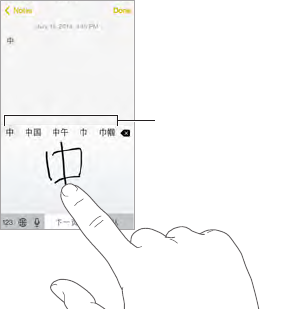
Appendix B International keyboards 148
•Japanese: Romaji and 50 Key
Reset your personal dictionary. Go to Settings > General > Reset > Reset Keyboard Dictionary.
All custom words and shortcuts are deleted, and the keyboard dictionary returns to its
default state.
Special input methods
Youcanusekeyboardstoentersomelanguagesindierentways.AfewexamplesareChinese
CangjieandWubihua,JapaneseKana,andFacemarks.Youcanalsouseyourngerorastylusto
write Chinese characters on the screen.
Build Chinese characters from the component Cangjie keys. As you type, suggested
charactersappear.Tapacharactertochooseit,orcontinuetypinguptovecomponentstosee
more options.
Build Chinese Wubihua (stroke) characters. Use the keypad to build Chinese characters using
uptovestrokes,inthecorrectwritingsequence:horizontal,vertical,leftfalling,rightfalling,and
hook. For example, the Chinese character 圈 (circle) should begin with the vertical stroke 丨.
•As you type, suggested Chinese characters appear (the most commonly used characters
appearrst).Tapacharactertochooseit.
•If you’re not sure of the correct stroke, enter an asterisk (*). To see more character options, type
another stroke, or scroll through the character list.
•Tap the match key (匹配) to show only characters that match exactly what you typed.
Write Chinese characters. WriteChinesecharactersdirectlyonthescreenwithyourngerwhen
SimpliedorTraditionalChinesehandwritinginputisturnedon.Asyouwritecharacterstrokes,
iPod touch recognizes them and shows matching characters in a list, with the closest match
at the top. When you choose a character, its likely follow-on characters appear in the list as
additional choices.
Matching characters
Matching characters
You can type some complex characters, such as 鱲 (part of the name for the Hong Kong
International Airport), by writing two or more component characters in sequence. Tap the
character to replace the characters you typed. Roman characters are also recognized.
Type Japanese kana. Use the Kana keypad to select syllables. For more syllable options, drag the
list to the left or tap the arrow key.
Type Japanese romaji. Use the Romaji keyboard to type syllables. Alternative choices appear
along the top of the keyboard; tap one to type it. For more syllable options, tap the arrow key
and select another syllable or word from the window.
Apple Confidential

Appendix B International keyboards 149
Type facemarks or emoticons. Use the Japanese Kana keyboard and tap the key. Or you can:
•Use the Japanese Romaji keyboard (QWERTY-Japanese layout): Tap , then tap the key.
•Use the Chinese (Simplied or Traditional) Pinyin or (Traditional) Zhuyin keyboard: Tap , then
tap the key.
Apple Confidential

C
150
Important safety information
WARNING: Failuretofollowthesesafetyinstructionscouldresultinre,electricshock,injury,
or damage to iPod touch or other property. Read all the safety information below before using
iPod touch.
Handling Handle iPod touch with care. It is made of metal, glass, and plastic and has sensitive
electronic components inside. iPod touch can be damaged if dropped, burned, punctured, or
crushed, or if it comes in contact with liquid. Don’t use a damaged iPod touch, such as one with
a cracked screen, as it may cause injury. If you’re concerned about scratching the surface of
iPod touch, consider using a case or cover.
Repairing Don’t open iPod touch and don’t attempt to repair iPod touch yourself. Disassembling
iPod touch may damage it or may cause injury to you. If iPod touch is damaged, malfunctions, or
comesincontactwithliquid,contactAppleoranAppleAuthorizedServiceProvider.Youcannd
more information about getting service at www.apple.com/support/ipod/service/faq.
Battery Don’t attempt to replace the iPod touch battery yourself—you may damage the
battery, which could cause overheating and injury. The lithium-ion battery in iPod touch should
be replaced only by Apple or an Apple Authorized Service Provider, and must be recycled or
disposed of separately from household waste. Don’t incinerate the battery. For information about
battery recycling and replacement, see www.apple.com/batteries/replacement-and-recycling.
Distraction Using iPod touch in some circumstances may distract you and might cause a
dangerous situation (for example, avoid using headphones while riding a bicycle). Observe rules
that prohibit or restrict the use of mobile devices or headphones.
Navigation Maps, directions, Flyover, and location-based apps depend on data services.
These data services are subject to change and may not be available in all areas, resulting in
maps, directions, Flyover, or location-based information that may be unavailable, inaccurate, or
incomplete. Some Maps features require Location Services. Compare the information provided
on iPod touch to your surroundings and defer to posted signs to resolve any discrepancies. Do
not use these services while performing activities that require your full attention. Always comply
with posted signs and the laws and regulations in the areas where you are using iPod touch and
always use common sense.
Safety, handling, and support
Appendix
Apple Confidential

Appendix C Safety, handling, and support 151
Charging Charge iPod touch with the included USB cable, or with other third-party “Made for
iPod” cables and power adapters that are compatible with USB 2.0 or later, or power adapters
compliant with applicable country regulations and with one or more of the following standards:
EN 301489-34, IEC 62684, YD/T 1591-2009, CNS 15285, ITU L.1000, or another applicable mobile
phone power adapter interoperability standard. An iPod touch Micro USB Adapter (available
separately in some areas) or other adapter may be needed to connect iPod touch to some
compatible power adapters. Only micro USB power adapters in certain regions that comply
with applicable mobile device power adapter interoperability standards are compatible. Please
contactthepoweradaptermanufacturertondoutifyourmicroUSBpoweradaptercomplies
with these standards.
Usingdamagedcablesorchargers,orchargingwhenmoistureispresent,cancausere,electric
shock, injury, or damage to iPod touch or other property. When you use the Apple USB Power
Adapter (sold separately) to charge iPod touch, make sure the USB cable is fully inserted into the
power adapter before you plug the adapter into a power outlet.
Lightning cable and connector Avoid prolonged skin contact with the connector when the
Lightning to USB Cable is plugged into a power source because it may cause discomfort or
injury. Situations such as sleeping or sitting on the Lightning connector should be avoided.
Prolonged heat exposure iPod touch and its power adapter (available separately) comply
with applicable surface temperature standards and limits. However, even within these limits,
sustained contact with warm surfaces for long periods of time may cause discomfort or injury.
Use common sense to avoid situations where your skin is in contact with a device or its power
adapter when it’s operating or plugged into a power source for long periods of time. For
example, don’t sleep on a device or power adapter, or place them under a blanket, pillow, or your
body, when it’s plugged into a power source. It’s important to keep iPod touch and its power
adapter in a well-ventilated area when in use or charging. Take special care if you have a physical
conditionthataectsyourabilitytodetectheatagainstthebody.
Hearing loss Listening to sound at high volumes may damage your hearing. Background noise,
as well as continued exposure to high volume levels, can make sounds seem quieter than they
actually are. Turn on audio playback and check the volume before inserting anything in your ear.
For more information about hearing loss, see www.apple.com/sound. For information about how
to set a maximum volume limit on iPod touch, see Music settings on page 64.
To avoid hearing damage, use only compatible receivers, earbuds, headphones, speakerphones,
orearpieceswithiPodtouch.TheheadsetssoldwithiPhone4sorlaterinChina(identiableby
dark insulating rings on the plug) are designed to comply with Chinese standards and are only
compatible with iPhone 4s or later, iPad 2 or later, and iPod touch 5th generation.
WARNING: To prevent possible hearing damage, do not listen at high volume levels for
long periods.
Radio frequency exposure iPod touch uses radio signals to connect to wireless networks. For
information about radio frequency (RF) energy resulting from radio signals and steps you can
take to minimize exposure, go to Settings > General > About > Legal > RF Exposure or visit
www.apple.com/legal/rfexposure.
Apple Confidential
Appendix C Safety, handling, and support 152
Radio frequency interference Observe signs and notices that prohibit or restrict the use of
electronic devices (for example, in healthcare facilities or blasting areas). Although iPod touch
is designed, tested, and manufactured to comply with regulations governing radio frequency
emissions,suchemissionsfromiPodtouchcannegativelyaecttheoperationofotherelectronic
equipment,causingthemtomalfunction.TurnoiPodtouchoruseAirplaneModetoturno
the iPod touch wireless transmitters when use is prohibited, such as while traveling in aircraft, or
when asked to do so by authorities.
Medical device interference iPod touch contains components and radios that emit
electromagneticelds.iPodtouchalsocontainsmagnetsandtheincludedheadphonesalso
havemagnetsintheearbuds.Theseelectromagneticeldsandmagnetsmayinterferewith
pacemakers,debrillators,orothermedicaldevices.Maintainasafedistanceofseparation
between your medical device and iPod touch and the earbuds. Consult your physician and
medicaldevicemanufacturerforinformationspecictoyourmedicaldevice.Ifyoususpect
iPod touch is interfering with your pacemaker or any other medical device, stop using
iPod touch.
Not a medical device iPod touch and the Health app are not designed or intended for use in
the diagnosis of disease or other conditions, or in the cure, mitigation, treatment, or prevention
of disease.
Medical conditions Ifyouhaveanymedicalconditionthatyoubelievecouldbeaectedby
iPod touch (for example, seizures, blackouts, eyestrain, or headaches), consult with your physician
prior to using iPod touch.
Explosive atmospheres Charging or using iPod touch in any area with a potentially explosive
atmosphere,suchasareaswheretheaircontainshighlevelsofammablechemicals,
vapors, or particles (such as grain, dust, or metal powders), may be hazardous. Obey all signs
and instructions.
Repetitive motion When you perform repetitive activities such as typing or playing games on
iPod touch, you may experience discomfort in your hands, arms, wrists, shoulders, neck, or other
parts of your body. If you experience discomfort, stop using iPod touch and consult a physician.
High-consequence activities This device is not intended for use where the failure of the device
could lead to death, personal injury, or severe environmental damage.
iPod touch loop (available on some models) To attach the loop securely, press the button
on the back of iPod touch to pop it up, slip the loop tab over the button, then pull the loop
to snap it into place. Certain activities when using the iPod touch loop may pose a risk of
injury, especially if the loop becomes caught or trapped—for example, while working around
machinery.Don’tswingiPodtouchwhileusingtheloop,astheloopmightcomeo,causing
injury or damage.
Choking hazard Some iPod touch accessories may present a choking hazard to small children.
Keep these accessories away from small children.
Important handling information
Cleaning Clean iPod touch immediately if it comes in contact with anything that may cause
stains—such as dirt, ink, makeup, or lotions. To clean:
•DisconnectallcablesandturniPodtoucho(pressandholdtheSleep/Wakebutton,then
slide the onscreen slider).
Apple Confidential
Appendix C Safety, handling, and support 153
•Use a soft, lint-free cloth.
•Avoid getting moisture in openings.
•Don’t use cleaning products or compressed air.
ThefrontofiPodtouchismadeofglasswithangerprint-resistantoleophobic(oilrepellant)
coating. This coating wears over time with normal usage. Cleaning products and abrasive
materials will further diminish the coating, and may scratch the glass.
Using connectors, ports, and buttons Never force a connector into a port or apply excessive
pressure to a button, because this may cause damage that is not covered under the warranty. If
the connector and port don’t join with reasonable ease, they probably don’t match. Check for
obstructions and make sure that the connector matches the port and that you have positioned
the connector correctly in relation to the port.
Lightning to USB Cable Discoloration of the Lightning connector after regular use is normal.
Dirt, debris, and exposure to moisture may cause discoloration. If your Lightning cable or
connector become warm during use or iPod touch won’t charge or sync, disconnect it from your
computer or power adapter and clean the Lightning connector with a soft, dry, lint-free cloth. Do
not use liquids or cleaning products when cleaning the Lightning connector.
Certain usage patterns can contribute to the fraying or breaking of cables. The Lightning to USB
Cable, like any other metal wire or cable, is subject to becoming weak or brittle if repeatedly bent
in the same spot. Aim for gentle curves instead of angles in the cable. Regularly inspect the cable
andconnectorforanykinks,breaks,bends,orotherdamage.Shouldyoundanysuchdamage,
discontinue use of the Lightning to USB Cable.
Operating temperature iPod touch is designed to work in ambient temperatures between
32° and 95° F (0° and 35° C) and stored in temperatures between -4° and 113° F (-20° and 45° C).
iPod touch can be damaged and battery life shortened if stored or operated outside of these
temperature ranges. Avoid exposing iPod touch to dramatic changes in temperature or humidity.
When you’re using iPod touch or charging the battery, it is normal for iPod touch to get warm.
If the interior temperature of iPod touch exceeds normal operating temperatures (for example, in
a hot car or in direct sunlight for extended periods of time), you may experience the following as
it attempts to regulate its temperature:
•iPod touch stops charging.
•The screen dims.
•A temperature warning screen appears.
•Some apps may close.
Important: You may not be able to use iPod touch while the temperature warning screen is
displayed. If iPod touch can’t regulate its internal temperature, it goes into deep sleep mode
until it cools. Move iPod touch to a cooler location out of direct sunlight and wait a few minutes
before trying to use iPod touch again.
For more information, see support.apple.com/kb/HT2101.
iPod touch Support site
Comprehensive support information is available online at www.apple.com/support/ipodtouch.
To contact Apple for personalized support (not available in all areas), see
www.apple.com/support/contact.
Apple Confidential
Appendix C Safety, handling, and support 154
Restart or reset iPod touch
If something isn’t working right, try restarting iPod touch, forcing an app to quit, or resetting
iPod touch.
Restart iPod touch. HolddowntheSleep/Wakebuttonuntilthesliderappears.Slideyournger
acrosstheslidertoturnoiPodtouch.ToturniPodtouchbackon,holddowntheSleep/Wake
button until the Apple logo appears.
iPod touch may be low on power. Connect iPod touch to the USB power adapter to charge. See
Charge and monitor the battery.
Force an app to quit. From the Home screen, double-click the Home button and swipe upwards
on the app screen.
Ifyoucan’tturnoiPodtouchoriftheproblemcontinues,youmayneedtoresetiPodtouch.Do
this only if you’re unable to restart your iPod touch.
Reset iPod touch. Hold down the Sleep/Wake button and the Home button at the same time for
at least ten seconds, until the Apple logo appears.
You can reset the word dictionary, network settings, home screen layout, and location warnings.
You can also erase all of your content and settings.
Reset iPod touch settings
Reset iPod touch settings. Go to Settings > General > Reset, then choose an option:
•Reset All Settings: All your preferences and settings are reset.
•Erase All Content and Settings: Your information, and settings are removed. iPod touch cannot
be used until it’s set up again.
•Reset Network Settings: When you reset network settings, previously used networks and VPN
settingsthatweren’tinstalledbyacongurationproleareremoved.(ToremoveVPNsettings
installedbyacongurationprole,gotoSettings>General>Prole,selecttheprole,then
tapRemove.Thisalsoremovesothersettingsoraccountsprovidedbytheprole.)Wi-Fiis
turnedoandthenbackon,disconnectingyoufromanynetworkyou’reon.TheWi-Fiand
“Ask to Join Networks” settings remain turned on.
•Reset Keyboard Dictionary: You add words to the keyboard dictionary by rejecting words
iPod touch suggests as you type. Resetting the keyboard dictionary erases all words
you’ve added.
•Reset Home Screen Layout: Returns the built-in apps to their original layout on the
Home screen.
•Reset Location & Privacy: Resets the location services and privacy settings to their defaults.
Get information about your iPod touch
See information about iPod touch. Go to Settings > General > About. The items you can view
include:
•Name
•Number of songs, videos, photos, and apps
•Capacity and available storage space
•iOS version
•Model number
Apple Confidential
Appendix C Safety, handling, and support 155
•Serial number
•Wi-Fi and Bluetooth addresses
•Legal (including legal notices, and license, warranty, regulatory marks, and RF exposure
information)
Tocopytheserialnumberandotheridentiers,touchandholdtheidentieruntilCopyappears.
To help Apple improve products and services, iPod touch sends diagnostic and usage data. This
data doesn’t personally identify you, but may include location information.
View or turn o diagnostic information. Go to Settings > Privacy > Diagnostics & Usage.
Usage information
View usage information. Go to Settings > General > Usage to:
•See Battery Usage, including the elapsed time since iPod touch has been charged and usage
by app
•View overall storage availability and storage used per app
•View and manage iCloud storage
Disabled iPod touch
If iPod touch is disabled because you forgot your passcode or entered an incorrect passcode too
many times, you can restore iPod touch from an iTunes or iCloud backup and reset the passcode.
Restoring erases the content and settings on iPod touch, but uses a backup to replace your data
and settings. For more information, see Restore iPod touch on page 157 and Back up iPod touch,
below.
If you get a message in iTunes that iPod touch is locked and you must enter a passcode, see
support.apple.com/kb/HT1212.
VPN settings
A VPN (virtual private network) provides secure access over the Internet to private networks,
such as the network at your organization. You may need to install a VPN app from the App Store
thatconguresyouriPodtouchtoaccessanetwork.Contactyoursystemadministratorfor
information about the app and settings you need.
Proles settings
CongurationprolesdenesettingsforusingiPodtouchwithcorporateorschoolnetworksor
accounts.Youmightbeaskedtoinstallacongurationprolethatwassenttoyouinanemail,
or one that is downloaded from a webpage. iPod touch asks for your permission to install the
prole,anddisplaysinformationaboutwhatitcontains,whenyouopenthele.Youcansee
theprolesyouhaveinstalledinSettings>General>Proles.Ifyoudeleteaprole,allofthe
settings,apps,anddataassociatedwiththeprolearealsodeleted.
Apple Confidential
Appendix C Safety, handling, and support 156
Back up iPod touch
You can use iCloud or iTunes to automatically back up iPod touch. If you choose to back up using
iCloud, you can’t also use iTunes to automatically back up to your computer, but you can use
iTunes to manually back up to your computer. iCloud backs up iPod touch daily over Wi-Fi, when
it’s connected to a power source and is locked. The date and time of the last backup is listed at
the bottom of the Storage & Backup screen.
iCloud backs up your:
•Purchased music, movies, TV shows, apps, and books
•Photos and videos taken with iPod touch (if you use iCloud Photo Library, your photos and
videos are already stored in iCloud, so they won’t also be part of an iCloud backup)
•iPod touch settings
•App data
•Home screen, folders, and app layout
•Messages
Note: Purchased content is not backed up in all areas.
Turn on iCloud backups. Go to Settings > iCloud, then log in with your Apple ID and password
if required. Go to Backup, then turn on iCloud Backup. To turn on backups in iTunes on your
computer, go to File > Devices > Back Up.
Back up immediately. Go to Settings > iCloud > Backup, then tap Back Up Now.
Encrypt your backup. iCloud backups are encrypted automatically so that your data is protected
from unauthorized access both while it’s transmitted to your devices and when it’s stored
in iCloud. If you’re using iTunes for your backup, select “Encrypt iPod backup” in the iTunes
Summary pane.
Manage your backups. Go to Settings > iCloud. You can manage which apps are backed up
toiCloudbytappingthemonoro.GotoSettings>iCloud>Storage>ManageStorageto
remove existing backups and manage iCloud Drive or Documents & Data. In iTunes, remove
backups in iTunes Preferences.
View the devices being backed up. Go to Settings > iCloud > Storage > Manage Storage.
Stop iCloud backups. GotoSettings>iCloud>Backup,thenturnoiCloudBackup.
Music not purchased in iTunes isn’t backed up in iCloud. Use iTunes to back up and restore that
content. See Sync with iTunes on page 16.
Important: Backups for music, movies, or TV show purchases are not available in all countries.
Previous purchases may not be restored if they are no longer in the iTunes Store, App Store, or
iBooks Store.
Purchased content, iCloud Photo Sharing, and My Photo Stream content don’t count against your
5 GB of free iCloud storage.
For more information about backing up iPod touch, see support.apple.com/kb/HT5262.
Apple Confidential

Appendix C Safety, handling, and support 157
Update and restore iPod touch software
About update and restore
You can update iPod touch software in Settings, or by using iTunes. You can also erase or restore
iPod touch, and then use iCloud or iTunes to restore from a backup.
Update iPod touch
You can update software in iPod touch Settings or by using iTunes.
Update wirelessly on iPod touch. Go to Settings > General > Software Update. iPod touch
checks for available software updates.
Update software in iTunes. iTunes checks for available software updates each time you sync
iPod touch using iTunes. See Sync with iTunes on page 16.
For more information about updating iPod touch software, see support.apple.com/kb/HT4623.
Restore iPod touch
You can use iCloud or iTunes to restore iPod touch from a backup.
Restore from an iCloud backup. Reset iPod touch to erase all content and settings, then
choose Restore from a Backup and sign in to iCloud in the Setup Assistant. See Restart or reset
iPod touch on page 154.
Restore from an iTunes backup. Connect iPod touch to the computer you normally sync with,
select iPod touch in the iTunes window, then click Restore in the Summary pane.
When the iPod touch software is restored, you can either set it up as a new iPod touch, or restore
your music, videos, app data, and other content from a backup.
For more information about restoring iPod touch software, see support.apple.com/kb/HT1414.
Sell or give away iPod touch
Before you sell or give away your iPod touch, be sure to erase all content and your personal
information. If you enabled Find My iPod touch (see Find My iPod touch on page 39), Activation
Lockison.YouneedtoturnoActivationLockbeforethenewownercanactivateiPodtouch
under his or her own account.
Erase iPod touch and remove Activation Lock. Go to Settings > General > Reset > Erase All
Content and Settings.
See support.apple.com/kb/HT5661.
Learn more, service, and support
Refer to the following resources to get more iPod touch-related safety, software, and
service information.
To learn about Do this
Using iPod touch safely See Important safety information on page 150.
iPod touch service and support, tips, forums, and
Apple software downloads
Go to www.apple.com/support/ipodtouch.
The latest information about iPod touch Go to www.apple.com/ipod-touch.
Apple Confidential

Appendix C Safety, handling, and support 158
To learn about Do this
Managing your Apple ID account Go to appleid.apple.com.
Using iCloud Go to help.apple.com/icloud.
Using iTunes Open iTunes, then choose Help > iTunes Help. For
an online iTunes tutorial (may not be available in all
areas), go to www.apple.com/support/itunes.
Using other Apple iOS apps Go to www.apple.com/support/ios.
Obtaining warranty service First follow the advice in this guide. Then go to
www.apple.com/support/ipodtouch.
Viewing iPod touch regulatory information On iPod touch, go to Settings > General > About >
Legal > Regulatory.
Battery replacement service Go to apple.com/batteries/replacement-and-recycling.
FCC compliance statement
This device complies with part 15 of the FCC rules. Operation is subject to the following two
conditions: (1) This device may not cause harmful interference, and (2) this device must accept
any interference received, including interference that may cause undesired operation.
Note: This equipment has been tested and found to comply with the limits for a Class B digital
device, pursuant to part 15 of the FCC Rules. These limits are designed to provide reasonable
protection against harmful interference in a residential installation. This equipment generates,
uses, and can radiate radio frequency energy and, if not installed and used in accordance with
the instructions, may cause harmful interference to radio communications. However, there is
no guarantee that interference will not occur in a particular installation. If this equipment does
cause harmful interference to radio or television reception, which can be determined by turning
theequipmentoandon,theuserisencouragedtotrytocorrecttheinterferencebyoneor
more of the following measures:
•Reorient or relocate the receiving antenna.
•Increase the separation between the equipment and receiver.
•Connecttheequipmenttoanoutletonacircuitdierentfromthattowhichthereceiver
is connected.
•Consult the dealer or an experienced radio/TV technician for help.
Important: ChangesormodicationstothisproductnotauthorizedbyApplecouldvoid
the electromagnetic compatibility (EMC) and wireless compliance and negate your authority
to operate the product. This product has demonstrated EMC compliance under conditions
that included the use of compliant peripheral devices and shielded cables between system
components. It is important that you use compliant peripheral devices and shielded cables
between system components to reduce the possibility of causing interference to radios,
televisions, and other electronic devices.
Canadian regulatory statement
This device complies with Industry Canada licence-exempt RSS standard(s). Operation is subject
to the following two conditions: (1) this device may not cause interference, and (2) this device
must accept any interference, including interference that may cause undesired operation of
the device.
Apple Confidential

Appendix C Safety, handling, and support 159
Operation in the band 5150-5250 MHz is only for indoor use to reduce the potential for harmful
interference to co-channel mobile satellite systems.
Users are advised that high-power radars are allocated as primary users (i.e., priority users) of the
bands 5250-5350 MHz and 5650-5850 MHz and that these radars could cause interference and/or
damage to LE-LAN devices.
Le présent appareil est conforme aux CNR d’Industrie Canada applicables aux appareils
radio exempts de licence. L’exploitation est autorisée aux deux conditions suivantes : (1)
l’appareil ne doit pas produire de brouillage, et (2) l’utilisateur de l’appareil doit accepter tout
brouillage radioélectrique subi, même si le brouillage est susceptible d’en compromettre
le fonctionnement.
Labande5150-5250MHzestréservésuniquementpouruneutilisationàl’intérieurande
réduire les risques de brouillage préjudiciable aux systèmes de satellites mobiles utilisant les
mêmes canaux.
Les utilisateurs êtes avisés que les utilisateurs de radars de haute puissance sont désignés
utilisateurs principaux (c.-à-d., qu’ils ont la priorité) pour les bandes 5 250-5 350 MHz et 5 650-5
850 MHz et que ces radars pourraient causer du brouillage et/ou des dommages aux dispositifs
LAN-EL.
CAN ICES-3 (B)/NMB-3(B)
Disposal and recycling information
Your iPod touch and/or battery should not be disposed of with household waste. Dispose of
your iPod touch and/or battery in accordance with local environmental laws and guidelines.
For information about the recycling program at Apple and recycling collection points, visit
www.apple.com/recycling. For information about restricted substances and other environmental
initiatives at Apple, visit www.apple.com/environment.
Battery replacement: The lithium-ion battery in iPod touch should be replaced by Apple or
an authorized service provider. For more information about battery replacement services, go
to www.apple.com/batteries/replacement-and-recycling.
Türkiye
Türkiye Cumhuriyeti: EEE Yönetmeliğine Uygundur.
Taiwan Battery Statement
China Battery Statement
Apple Confidential

Appendix C Safety, handling, and support 160
European Union—Disposal information
The symbol above means that according to local laws and regulations your product and/or its
battery shall be disposed of separately from household waste. When this product reaches its
end of life, take it to a collection point designated by local authorities. The separate collection
and recycling of your product and/or its battery at the time of disposal will help conserve
natural resources and ensure that it is recycled in a manner that protects human health and
the environment.
Union Européenne—informations sur l’élimination: Lesymboleci-dessussignieque,
conformément aux lois et réglementations locales, vous devez jeter votre produit et/
ousabatterieséparémentdesorduresménagères.Lorsqueceproduitarriveenndevie,
apportez-le à un point de collecte désigné par les autorités locales. La collecte séparée et le
recyclage de votre produit et/ou de sa batterie lors de sa mise au rebut aideront à préserver les
ressources naturelles et à s’assurer qu’il est recyclé de manière à protéger la santé humaine et
l’environnement.
Europäische Union—Informationen zur Entsorgung: Das oben aufgeführte Symbol weist darauf
hin, dass dieses Produkt und/oder die damit verwendete Batterie den geltenden gesetzlichen
Vorschriften entsprechend und vom Hausmüll getrennt entsorgt werden muss. Geben Sie dieses
ProduktzurEntsorgungbeieineroziellenSammelstelleab.DurchgetrenntesSammelnund
RecyclingwerdendieRohstoreservengeschontundesistsichergestellt,dassbeimRecycling
des Produkts und/oder der Batterie alle Bestimmungen zum Schutz von Gesundheit und Umwelt
eingehalten werden.
Unione Europea—informazioni per lo smaltimento: Ilsimboloquisoprasignicache,inbase
alle leggi e alle normative locali, il prodotto e/o la sua batteria dovrebbero essere riciclati
separatamentedairiutidomestici.Quandoilprodottodiventainutilizzabile,portalonelpunto
di raccolta stabilito dalle autorità locali. La raccolta separata e il riciclaggio del prodotto e/o della
sua batteria al momento dello smaltimento aiutano a conservare le risorse naturali e assicurano
che il riciclaggio avvenga nel rispetto della salute umana e dell’ambiente.
Europeiska unionen—information om kassering: Symbolen ovan betyder att produkten
och/eller dess batteri enligt lokala lagar och bestämmelser inte får kastas tillsammans med
hushållsavfallet. När produkten har tjänat ut måste den tas till en återvinningsstation som utsetts
av lokala myndigheter. Genom att låta den uttjänta produkten och/eller dess batteri tas om hand
för återvinning hjälper du till att spara naturresurser och skydda hälsa och miljö.
Brasil—Informações sobre descarte e reciclagem
O símbolo indica que este produto e/ou sua bateria não devem ser descartadas no lixo
doméstico. Quando decidir descartar este produto e/ou sua bateria, faça-o de acordo com
as leis e diretrizes ambientais locais. Para informações sobre substâncias de uso restrito,
o programa de reciclagem da Apple, pontos de coleta e telefone de informações, visite
www.apple.com/br/environment.
Apple Confidential

Appendix C Safety, handling, and support 161
Información sobre eliminación de residuos y reciclaje
El símbolo indica que este producto y/o su batería no debe desecharse con los residuos
domésticos. Cuando decida desechar este producto y/o su batería, hágalo de conformidad
con las leyes y directrices ambientales locales. Para obtener información sobre el programa de
reciclaje de Apple, puntos de recolección para reciclaje, sustancias restringidas y otras iniciativas
ambientales, visite www.apple.com/la/environment.
Apple and the environment
At Apple, we recognize our responsibility to minimize the environmental impacts of our
operations and products. For more information, go to www.apple.com/environment.
Apple Confidential
K
Apple Inc.
© 2015 Apple Inc. All rights reserved.
Apple, the Apple logo, AirDrop, AirPlay, AirPort, Apple TV,
FaceTime, Finder, GarageBand, Guided Access, iBooks, iMessage,
iPad, iPhone, iPod, iPod touch, iSight, iTunes, Keychain, Keynote,
Mac, the Made for iPod logo, Numbers, OS X, Pages, Passbook,
Safari, Siri, and Spotlight are trademarks of Apple Inc.,
registered in the U.S. and other countries.
AirPrint, EarPods, Flyover, iTunes Pass, Lightning, and Multi-
Touch are trademarks of Apple Inc.
Apple Store, Genius, iCloud, iTunes Extras, iTunes Match, iTunes
Plus, iTunes Store, iTunes U, and the Podcast logo are service
marks of Apple Inc., registered in the U.S. and other countries.
App Store, iBooks Store, and iTunes Radio are service marks of
Apple Inc.
IOS is a trademark or registered trademark of Cisco in the U.S.
and other countries and is used under license.
The Bluetooth® word mark and logos are registered
trademarks owned by Bluetooth SIG, Inc. and any use of such
marks by Apple Inc. is under license.
Other company and product names mentioned herein may be
trademarks of their respective companies.
Mention of third-party products is for informational
purposes only and constitutes neither an endorsement nor
a recommendation. Apple assumes no responsibility with
regard to the performance or use of these products. All
understandings, agreements, or warranties, if any, take place
directly between the vendors and the prospective users. Every
eorthasbeenmadetoensurethattheinformationinthis
manual is accurate. Apple is not responsible for printing or
clerical errors.
019-00128/2015-04
Apple Confidential